Marketing Challenges after COVID-19 : Principles of Marketing
VerifiedAdded on 2022/01/18
|24
|7103
|43
AI Summary
Contribute Materials
Your contribution can guide someone’s learning journey. Share your
documents today.
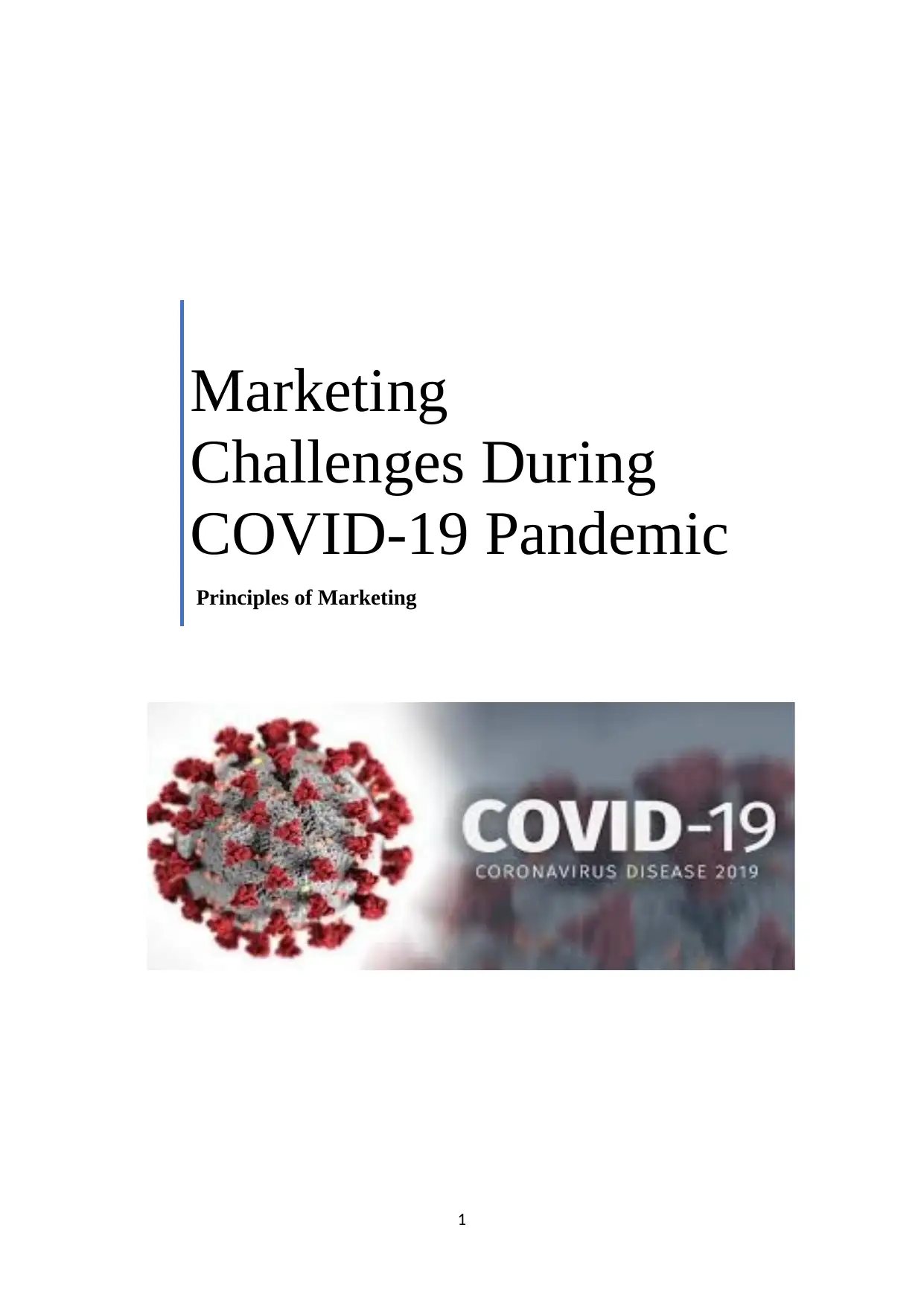
1
Marketing
Challenges During
COVID-19 Pandemic
Principles of Marketing
Marketing
Challenges During
COVID-19 Pandemic
Principles of Marketing
Secure Best Marks with AI Grader
Need help grading? Try our AI Grader for instant feedback on your assignments.
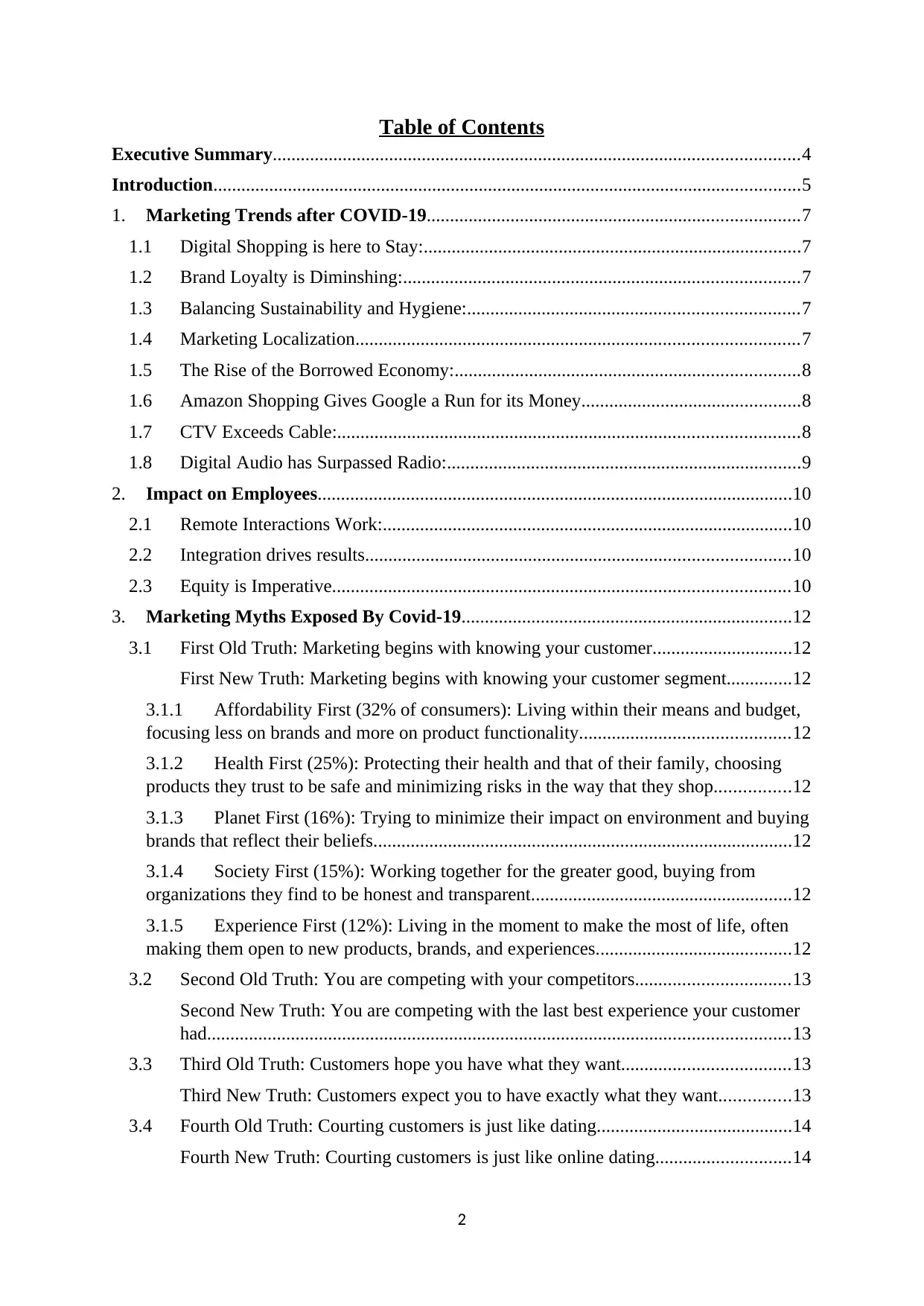
Table of Contents
Executive Summary.................................................................................................................4
Introduction..............................................................................................................................5
1. Marketing Trends after COVID-19................................................................................7
1.1 Digital Shopping is here to Stay:.................................................................................7
1.2 Brand Loyalty is Diminshing:.....................................................................................7
1.3 Balancing Sustainability and Hygiene:.......................................................................7
1.4 Marketing Localization...............................................................................................7
1.5 The Rise of the Borrowed Economy:..........................................................................8
1.6 Amazon Shopping Gives Google a Run for its Money...............................................8
1.7 CTV Exceeds Cable:...................................................................................................8
1.8 Digital Audio has Surpassed Radio:............................................................................9
2. Impact on Employees......................................................................................................10
2.1 Remote Interactions Work:........................................................................................10
2.2 Integration drives results...........................................................................................10
2.3 Equity is Imperative..................................................................................................10
3. Marketing Myths Exposed By Covid-19.......................................................................12
3.1 First Old Truth: Marketing begins with knowing your customer..............................12
First New Truth: Marketing begins with knowing your customer segment..............12
3.1.1 Affordability First (32% of consumers): Living within their means and budget,
focusing less on brands and more on product functionality.............................................12
3.1.2 Health First (25%): Protecting their health and that of their family, choosing
products they trust to be safe and minimizing risks in the way that they shop................12
3.1.3 Planet First (16%): Trying to minimize their impact on environment and buying
brands that reflect their beliefs..........................................................................................12
3.1.4 Society First (15%): Working together for the greater good, buying from
organizations they find to be honest and transparent........................................................12
3.1.5 Experience First (12%): Living in the moment to make the most of life, often
making them open to new products, brands, and experiences..........................................12
3.2 Second Old Truth: You are competing with your competitors.................................13
Second New Truth: You are competing with the last best experience your customer
had.............................................................................................................................13
3.3 Third Old Truth: Customers hope you have what they want....................................13
Third New Truth: Customers expect you to have exactly what they want...............13
3.4 Fourth Old Truth: Courting customers is just like dating..........................................14
Fourth New Truth: Courting customers is just like online dating.............................14
2
Executive Summary.................................................................................................................4
Introduction..............................................................................................................................5
1. Marketing Trends after COVID-19................................................................................7
1.1 Digital Shopping is here to Stay:.................................................................................7
1.2 Brand Loyalty is Diminshing:.....................................................................................7
1.3 Balancing Sustainability and Hygiene:.......................................................................7
1.4 Marketing Localization...............................................................................................7
1.5 The Rise of the Borrowed Economy:..........................................................................8
1.6 Amazon Shopping Gives Google a Run for its Money...............................................8
1.7 CTV Exceeds Cable:...................................................................................................8
1.8 Digital Audio has Surpassed Radio:............................................................................9
2. Impact on Employees......................................................................................................10
2.1 Remote Interactions Work:........................................................................................10
2.2 Integration drives results...........................................................................................10
2.3 Equity is Imperative..................................................................................................10
3. Marketing Myths Exposed By Covid-19.......................................................................12
3.1 First Old Truth: Marketing begins with knowing your customer..............................12
First New Truth: Marketing begins with knowing your customer segment..............12
3.1.1 Affordability First (32% of consumers): Living within their means and budget,
focusing less on brands and more on product functionality.............................................12
3.1.2 Health First (25%): Protecting their health and that of their family, choosing
products they trust to be safe and minimizing risks in the way that they shop................12
3.1.3 Planet First (16%): Trying to minimize their impact on environment and buying
brands that reflect their beliefs..........................................................................................12
3.1.4 Society First (15%): Working together for the greater good, buying from
organizations they find to be honest and transparent........................................................12
3.1.5 Experience First (12%): Living in the moment to make the most of life, often
making them open to new products, brands, and experiences..........................................12
3.2 Second Old Truth: You are competing with your competitors.................................13
Second New Truth: You are competing with the last best experience your customer
had.............................................................................................................................13
3.3 Third Old Truth: Customers hope you have what they want....................................13
Third New Truth: Customers expect you to have exactly what they want...............13
3.4 Fourth Old Truth: Courting customers is just like dating..........................................14
Fourth New Truth: Courting customers is just like online dating.............................14
2
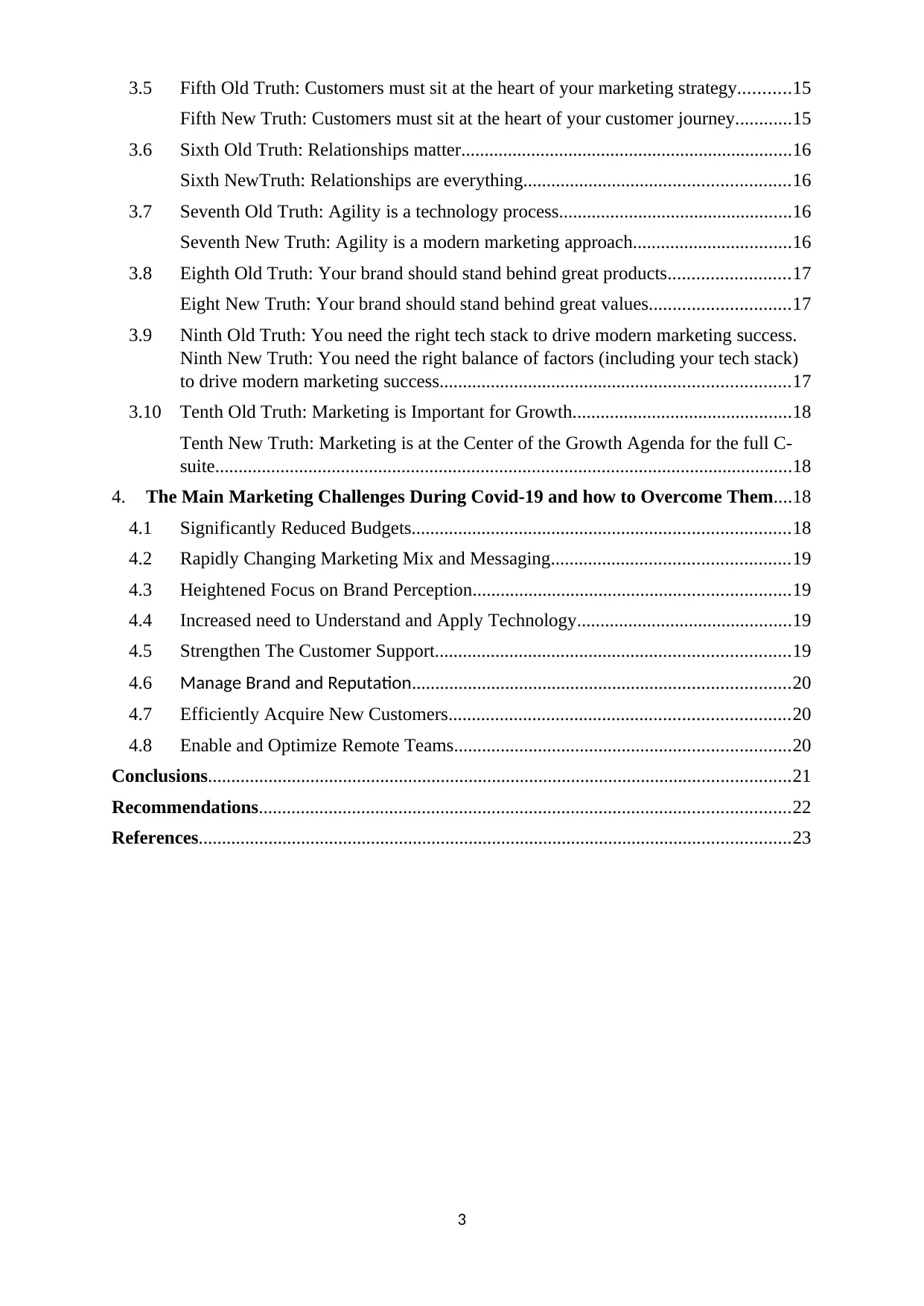
3.5 Fifth Old Truth: Customers must sit at the heart of your marketing strategy...........15
Fifth New Truth: Customers must sit at the heart of your customer journey............15
3.6 Sixth Old Truth: Relationships matter.......................................................................16
Sixth NewTruth: Relationships are everything.........................................................16
3.7 Seventh Old Truth: Agility is a technology process..................................................16
Seventh New Truth: Agility is a modern marketing approach..................................16
3.8 Eighth Old Truth: Your brand should stand behind great products..........................17
Eight New Truth: Your brand should stand behind great values..............................17
3.9 Ninth Old Truth: You need the right tech stack to drive modern marketing success.
Ninth New Truth: You need the right balance of factors (including your tech stack)
to drive modern marketing success...........................................................................17
3.10 Tenth Old Truth: Marketing is Important for Growth...............................................18
Tenth New Truth: Marketing is at the Center of the Growth Agenda for the full C-
suite............................................................................................................................18
4. The Main Marketing Challenges During Covid-19 and how to Overcome Them....18
4.1 Significantly Reduced Budgets.................................................................................18
4.2 Rapidly Changing Marketing Mix and Messaging...................................................19
4.3 Heightened Focus on Brand Perception....................................................................19
4.4 Increased need to Understand and Apply Technology..............................................19
4.5 Strengthen The Customer Support............................................................................19
4.6 Manage Brand and Reputation.................................................................................20
4.7 Efficiently Acquire New Customers.........................................................................20
4.8 Enable and Optimize Remote Teams........................................................................20
Conclusions.............................................................................................................................21
Recommendations..................................................................................................................22
References...............................................................................................................................23
3
Fifth New Truth: Customers must sit at the heart of your customer journey............15
3.6 Sixth Old Truth: Relationships matter.......................................................................16
Sixth NewTruth: Relationships are everything.........................................................16
3.7 Seventh Old Truth: Agility is a technology process..................................................16
Seventh New Truth: Agility is a modern marketing approach..................................16
3.8 Eighth Old Truth: Your brand should stand behind great products..........................17
Eight New Truth: Your brand should stand behind great values..............................17
3.9 Ninth Old Truth: You need the right tech stack to drive modern marketing success.
Ninth New Truth: You need the right balance of factors (including your tech stack)
to drive modern marketing success...........................................................................17
3.10 Tenth Old Truth: Marketing is Important for Growth...............................................18
Tenth New Truth: Marketing is at the Center of the Growth Agenda for the full C-
suite............................................................................................................................18
4. The Main Marketing Challenges During Covid-19 and how to Overcome Them....18
4.1 Significantly Reduced Budgets.................................................................................18
4.2 Rapidly Changing Marketing Mix and Messaging...................................................19
4.3 Heightened Focus on Brand Perception....................................................................19
4.4 Increased need to Understand and Apply Technology..............................................19
4.5 Strengthen The Customer Support............................................................................19
4.6 Manage Brand and Reputation.................................................................................20
4.7 Efficiently Acquire New Customers.........................................................................20
4.8 Enable and Optimize Remote Teams........................................................................20
Conclusions.............................................................................................................................21
Recommendations..................................................................................................................22
References...............................................................................................................................23
3

Executive Summary
Covid-19 has shaken the entire world. To say it'd be the understatement of this sector of
the twenty first century. None of us have been organized for what it delivered, there's no
way all and sundry may be geared up for one of these catastrophic occasions. It delivered
plenty of desired and undesired effects. The advertising international changed into as
plenty impacted as all the other commercial enterprise factors.
4
Covid-19 has shaken the entire world. To say it'd be the understatement of this sector of
the twenty first century. None of us have been organized for what it delivered, there's no
way all and sundry may be geared up for one of these catastrophic occasions. It delivered
plenty of desired and undesired effects. The advertising international changed into as
plenty impacted as all the other commercial enterprise factors.
4
Secure Best Marks with AI Grader
Need help grading? Try our AI Grader for instant feedback on your assignments.
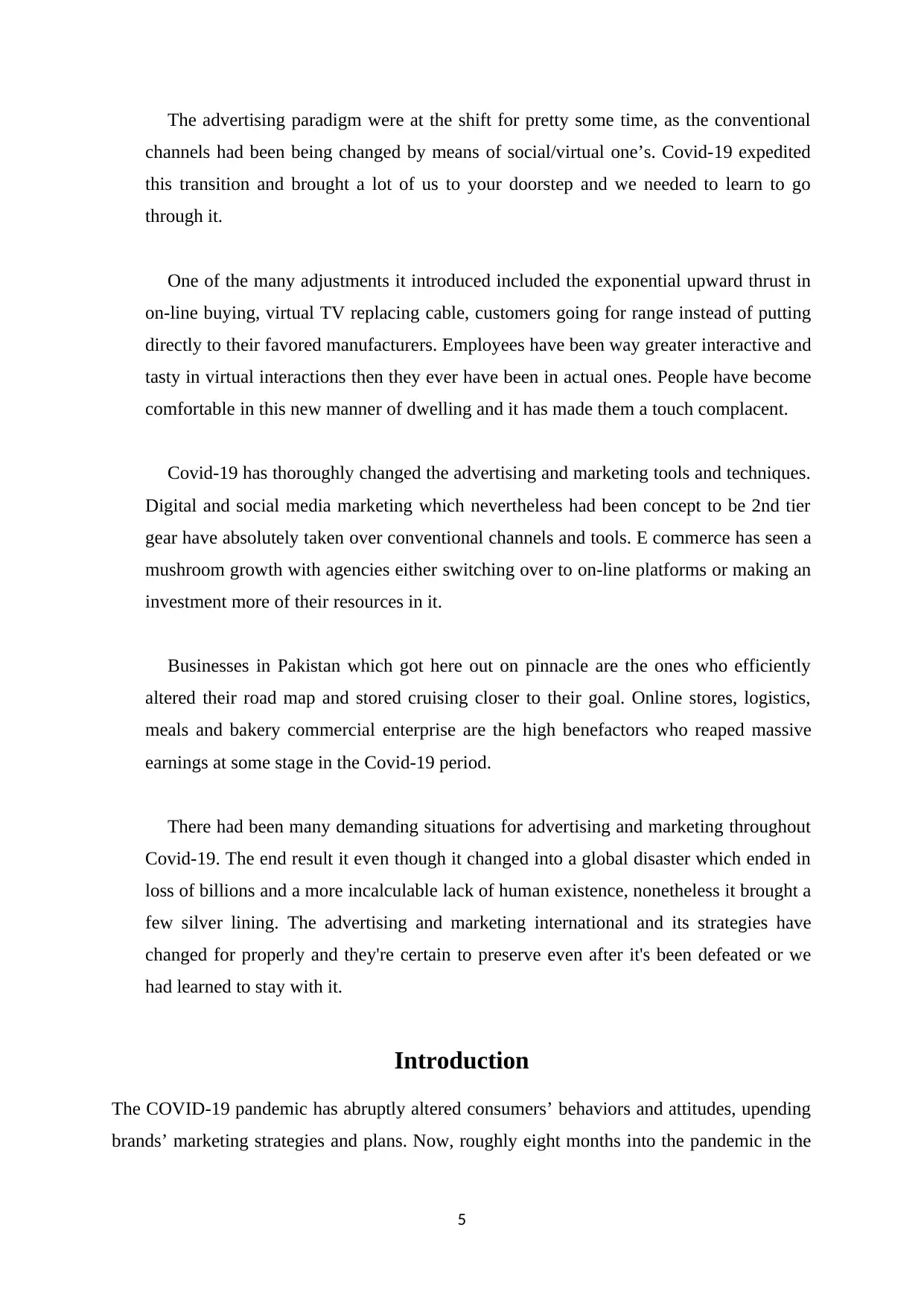
The advertising paradigm were at the shift for pretty some time, as the conventional
channels had been being changed by means of social/virtual one’s. Covid-19 expedited
this transition and brought a lot of us to your doorstep and we needed to learn to go
through it.
One of the many adjustments it introduced included the exponential upward thrust in
on-line buying, virtual TV replacing cable, customers going for range instead of putting
directly to their favored manufacturers. Employees have been way greater interactive and
tasty in virtual interactions then they ever have been in actual ones. People have become
comfortable in this new manner of dwelling and it has made them a touch complacent.
Covid-19 has thoroughly changed the advertising and marketing tools and techniques.
Digital and social media marketing which nevertheless had been concept to be 2nd tier
gear have absolutely taken over conventional channels and tools. E commerce has seen a
mushroom growth with agencies either switching over to on-line platforms or making an
investment more of their resources in it.
Businesses in Pakistan which got here out on pinnacle are the ones who efficiently
altered their road map and stored cruising closer to their goal. Online stores, logistics,
meals and bakery commercial enterprise are the high benefactors who reaped massive
earnings at some stage in the Covid-19 period.
There had been many demanding situations for advertising and marketing throughout
Covid-19. The end result it even though it changed into a global disaster which ended in
loss of billions and a more incalculable lack of human existence, nonetheless it brought a
few silver lining. The advertising and marketing international and its strategies have
changed for properly and they're certain to preserve even after it's been defeated or we
had learned to stay with it.
Introduction
The COVID-19 pandemic has abruptly altered consumers’ behaviors and attitudes, upending
brands’ marketing strategies and plans. Now, roughly eight months into the pandemic in the
5
channels had been being changed by means of social/virtual one’s. Covid-19 expedited
this transition and brought a lot of us to your doorstep and we needed to learn to go
through it.
One of the many adjustments it introduced included the exponential upward thrust in
on-line buying, virtual TV replacing cable, customers going for range instead of putting
directly to their favored manufacturers. Employees have been way greater interactive and
tasty in virtual interactions then they ever have been in actual ones. People have become
comfortable in this new manner of dwelling and it has made them a touch complacent.
Covid-19 has thoroughly changed the advertising and marketing tools and techniques.
Digital and social media marketing which nevertheless had been concept to be 2nd tier
gear have absolutely taken over conventional channels and tools. E commerce has seen a
mushroom growth with agencies either switching over to on-line platforms or making an
investment more of their resources in it.
Businesses in Pakistan which got here out on pinnacle are the ones who efficiently
altered their road map and stored cruising closer to their goal. Online stores, logistics,
meals and bakery commercial enterprise are the high benefactors who reaped massive
earnings at some stage in the Covid-19 period.
There had been many demanding situations for advertising and marketing throughout
Covid-19. The end result it even though it changed into a global disaster which ended in
loss of billions and a more incalculable lack of human existence, nonetheless it brought a
few silver lining. The advertising and marketing international and its strategies have
changed for properly and they're certain to preserve even after it's been defeated or we
had learned to stay with it.
Introduction
The COVID-19 pandemic has abruptly altered consumers’ behaviors and attitudes, upending
brands’ marketing strategies and plans. Now, roughly eight months into the pandemic in the
5
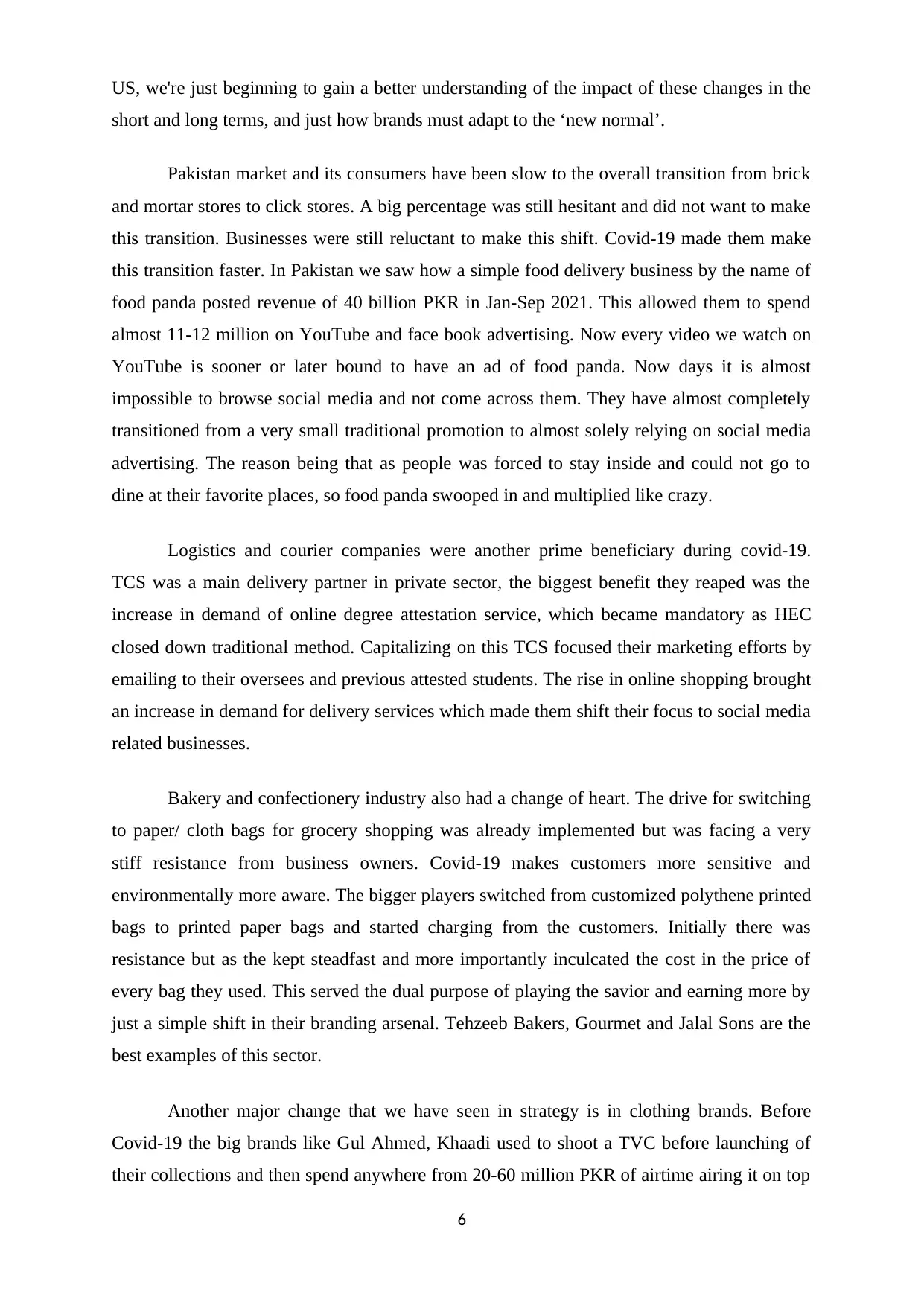
US, we're just beginning to gain a better understanding of the impact of these changes in the
short and long terms, and just how brands must adapt to the ‘new normal’.
Pakistan market and its consumers have been slow to the overall transition from brick
and mortar stores to click stores. A big percentage was still hesitant and did not want to make
this transition. Businesses were still reluctant to make this shift. Covid-19 made them make
this transition faster. In Pakistan we saw how a simple food delivery business by the name of
food panda posted revenue of 40 billion PKR in Jan-Sep 2021. This allowed them to spend
almost 11-12 million on YouTube and face book advertising. Now every video we watch on
YouTube is sooner or later bound to have an ad of food panda. Now days it is almost
impossible to browse social media and not come across them. They have almost completely
transitioned from a very small traditional promotion to almost solely relying on social media
advertising. The reason being that as people was forced to stay inside and could not go to
dine at their favorite places, so food panda swooped in and multiplied like crazy.
Logistics and courier companies were another prime beneficiary during covid-19.
TCS was a main delivery partner in private sector, the biggest benefit they reaped was the
increase in demand of online degree attestation service, which became mandatory as HEC
closed down traditional method. Capitalizing on this TCS focused their marketing efforts by
emailing to their oversees and previous attested students. The rise in online shopping brought
an increase in demand for delivery services which made them shift their focus to social media
related businesses.
Bakery and confectionery industry also had a change of heart. The drive for switching
to paper/ cloth bags for grocery shopping was already implemented but was facing a very
stiff resistance from business owners. Covid-19 makes customers more sensitive and
environmentally more aware. The bigger players switched from customized polythene printed
bags to printed paper bags and started charging from the customers. Initially there was
resistance but as the kept steadfast and more importantly inculcated the cost in the price of
every bag they used. This served the dual purpose of playing the savior and earning more by
just a simple shift in their branding arsenal. Tehzeeb Bakers, Gourmet and Jalal Sons are the
best examples of this sector.
Another major change that we have seen in strategy is in clothing brands. Before
Covid-19 the big brands like Gul Ahmed, Khaadi used to shoot a TVC before launching of
their collections and then spend anywhere from 20-60 million PKR of airtime airing it on top
6
short and long terms, and just how brands must adapt to the ‘new normal’.
Pakistan market and its consumers have been slow to the overall transition from brick
and mortar stores to click stores. A big percentage was still hesitant and did not want to make
this transition. Businesses were still reluctant to make this shift. Covid-19 made them make
this transition faster. In Pakistan we saw how a simple food delivery business by the name of
food panda posted revenue of 40 billion PKR in Jan-Sep 2021. This allowed them to spend
almost 11-12 million on YouTube and face book advertising. Now every video we watch on
YouTube is sooner or later bound to have an ad of food panda. Now days it is almost
impossible to browse social media and not come across them. They have almost completely
transitioned from a very small traditional promotion to almost solely relying on social media
advertising. The reason being that as people was forced to stay inside and could not go to
dine at their favorite places, so food panda swooped in and multiplied like crazy.
Logistics and courier companies were another prime beneficiary during covid-19.
TCS was a main delivery partner in private sector, the biggest benefit they reaped was the
increase in demand of online degree attestation service, which became mandatory as HEC
closed down traditional method. Capitalizing on this TCS focused their marketing efforts by
emailing to their oversees and previous attested students. The rise in online shopping brought
an increase in demand for delivery services which made them shift their focus to social media
related businesses.
Bakery and confectionery industry also had a change of heart. The drive for switching
to paper/ cloth bags for grocery shopping was already implemented but was facing a very
stiff resistance from business owners. Covid-19 makes customers more sensitive and
environmentally more aware. The bigger players switched from customized polythene printed
bags to printed paper bags and started charging from the customers. Initially there was
resistance but as the kept steadfast and more importantly inculcated the cost in the price of
every bag they used. This served the dual purpose of playing the savior and earning more by
just a simple shift in their branding arsenal. Tehzeeb Bakers, Gourmet and Jalal Sons are the
best examples of this sector.
Another major change that we have seen in strategy is in clothing brands. Before
Covid-19 the big brands like Gul Ahmed, Khaadi used to shoot a TVC before launching of
their collections and then spend anywhere from 20-60 million PKR of airtime airing it on top
6
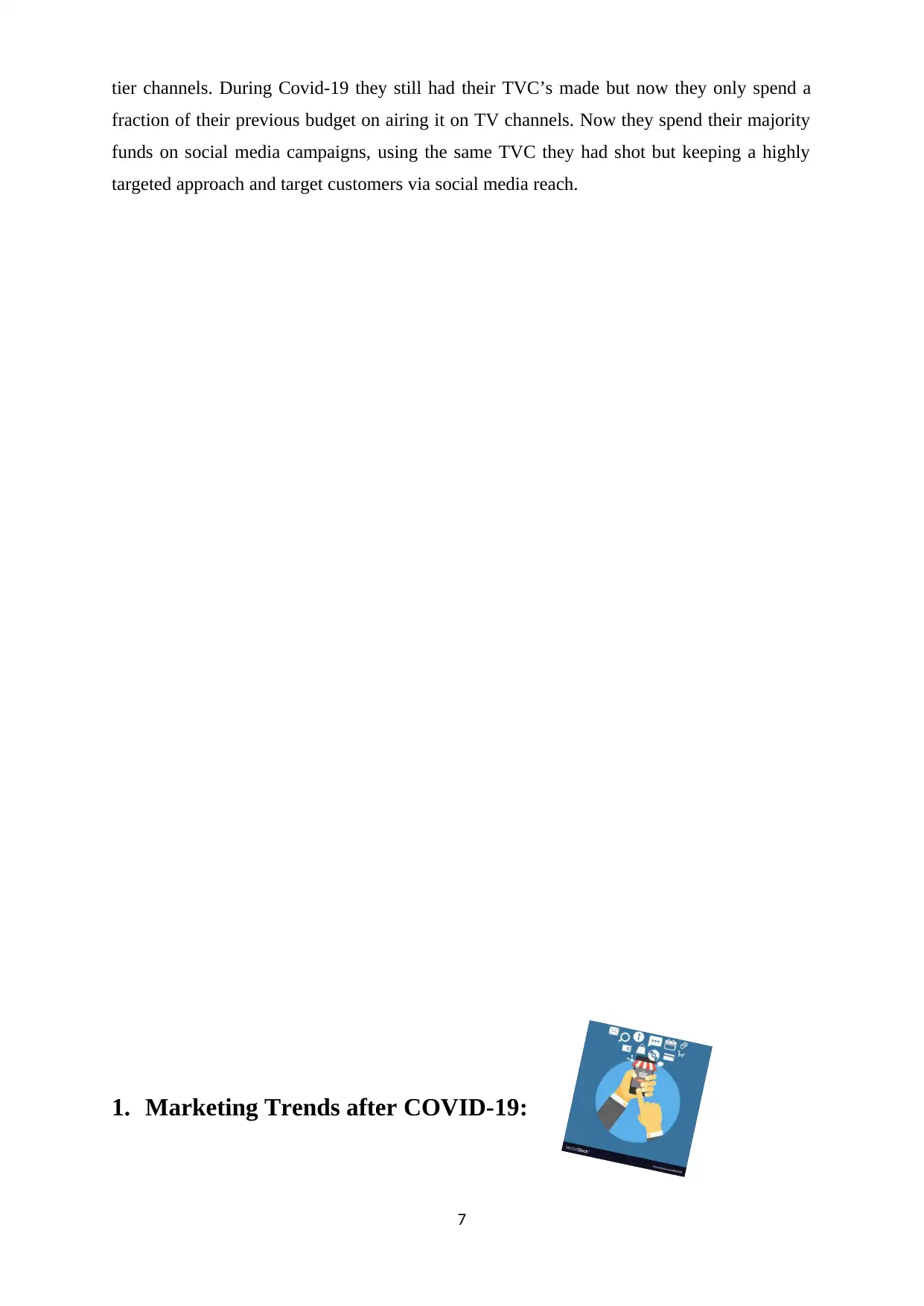
tier channels. During Covid-19 they still had their TVC’s made but now they only spend a
fraction of their previous budget on airing it on TV channels. Now they spend their majority
funds on social media campaigns, using the same TVC they had shot but keeping a highly
targeted approach and target customers via social media reach.
1. Marketing Trends after COVID-19:
7
fraction of their previous budget on airing it on TV channels. Now they spend their majority
funds on social media campaigns, using the same TVC they had shot but keeping a highly
targeted approach and target customers via social media reach.
1. Marketing Trends after COVID-19:
7
Paraphrase This Document
Need a fresh take? Get an instant paraphrase of this document with our AI Paraphraser
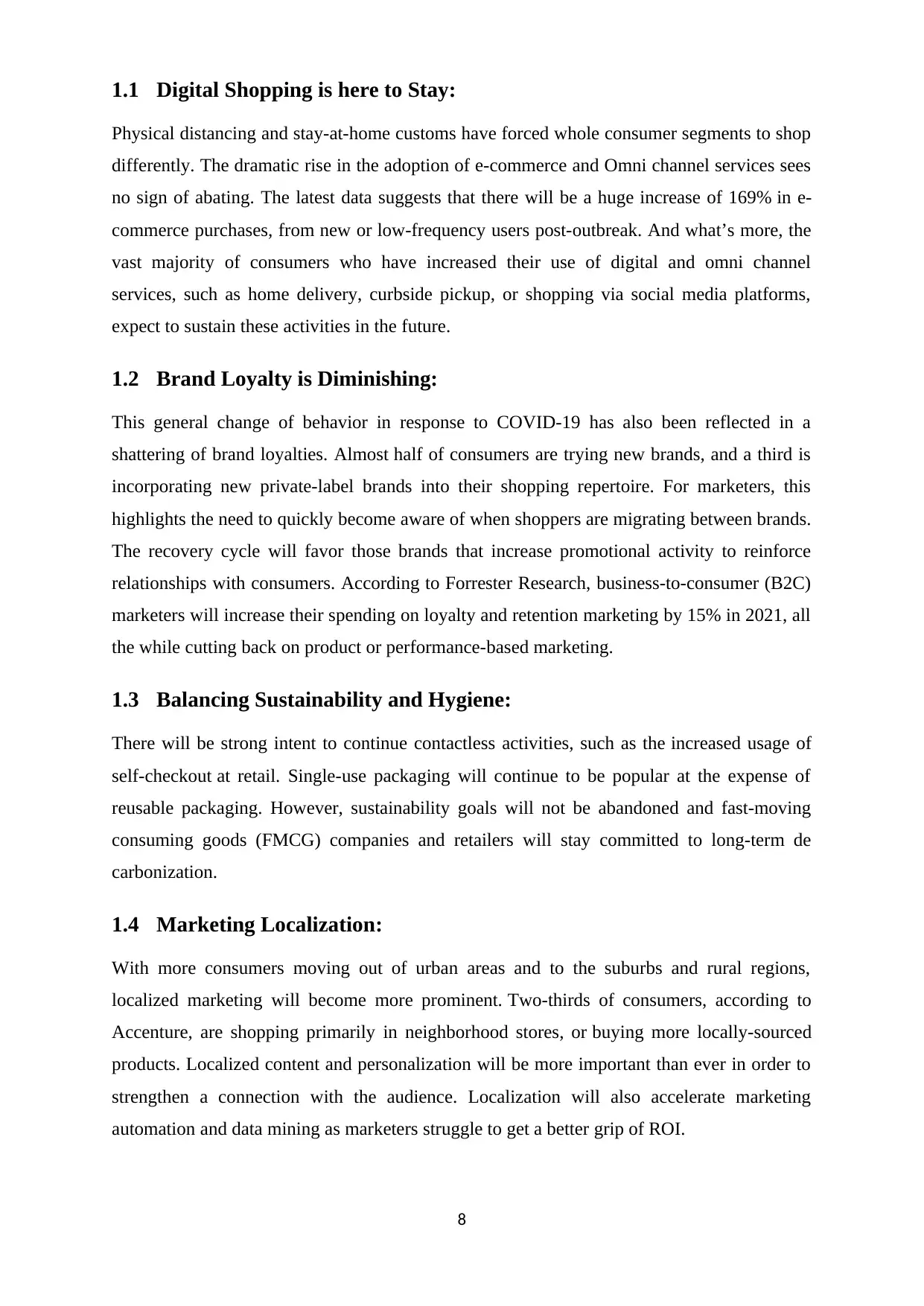
1.1 Digital Shopping is here to Stay:
Physical distancing and stay-at-home customs have forced whole consumer segments to shop
differently. The dramatic rise in the adoption of e-commerce and Omni channel services sees
no sign of abating. The latest data suggests that there will be a huge increase of 169% in e-
commerce purchases, from new or low-frequency users post-outbreak. And what’s more, the
vast majority of consumers who have increased their use of digital and omni channel
services, such as home delivery, curbside pickup, or shopping via social media platforms,
expect to sustain these activities in the future.
1.2 Brand Loyalty is Diminishing:
This general change of behavior in response to COVID-19 has also been reflected in a
shattering of brand loyalties. Almost half of consumers are trying new brands, and a third is
incorporating new private-label brands into their shopping repertoire. For marketers, this
highlights the need to quickly become aware of when shoppers are migrating between brands.
The recovery cycle will favor those brands that increase promotional activity to reinforce
relationships with consumers. According to Forrester Research, business-to-consumer (B2C)
marketers will increase their spending on loyalty and retention marketing by 15% in 2021, all
the while cutting back on product or performance-based marketing.
1.3 Balancing Sustainability and Hygiene:
There will be strong intent to continue contactless activities, such as the increased usage of
self-checkout at retail. Single-use packaging will continue to be popular at the expense of
reusable packaging. However, sustainability goals will not be abandoned and fast-moving
consuming goods (FMCG) companies and retailers will stay committed to long-term de
carbonization.
1.4 Marketing Localization:
With more consumers moving out of urban areas and to the suburbs and rural regions,
localized marketing will become more prominent. Two-thirds of consumers, according to
Accenture, are shopping primarily in neighborhood stores, or buying more locally-sourced
products. Localized content and personalization will be more important than ever in order to
strengthen a connection with the audience. Localization will also accelerate marketing
automation and data mining as marketers struggle to get a better grip of ROI.
8
Physical distancing and stay-at-home customs have forced whole consumer segments to shop
differently. The dramatic rise in the adoption of e-commerce and Omni channel services sees
no sign of abating. The latest data suggests that there will be a huge increase of 169% in e-
commerce purchases, from new or low-frequency users post-outbreak. And what’s more, the
vast majority of consumers who have increased their use of digital and omni channel
services, such as home delivery, curbside pickup, or shopping via social media platforms,
expect to sustain these activities in the future.
1.2 Brand Loyalty is Diminishing:
This general change of behavior in response to COVID-19 has also been reflected in a
shattering of brand loyalties. Almost half of consumers are trying new brands, and a third is
incorporating new private-label brands into their shopping repertoire. For marketers, this
highlights the need to quickly become aware of when shoppers are migrating between brands.
The recovery cycle will favor those brands that increase promotional activity to reinforce
relationships with consumers. According to Forrester Research, business-to-consumer (B2C)
marketers will increase their spending on loyalty and retention marketing by 15% in 2021, all
the while cutting back on product or performance-based marketing.
1.3 Balancing Sustainability and Hygiene:
There will be strong intent to continue contactless activities, such as the increased usage of
self-checkout at retail. Single-use packaging will continue to be popular at the expense of
reusable packaging. However, sustainability goals will not be abandoned and fast-moving
consuming goods (FMCG) companies and retailers will stay committed to long-term de
carbonization.
1.4 Marketing Localization:
With more consumers moving out of urban areas and to the suburbs and rural regions,
localized marketing will become more prominent. Two-thirds of consumers, according to
Accenture, are shopping primarily in neighborhood stores, or buying more locally-sourced
products. Localized content and personalization will be more important than ever in order to
strengthen a connection with the audience. Localization will also accelerate marketing
automation and data mining as marketers struggle to get a better grip of ROI.
8
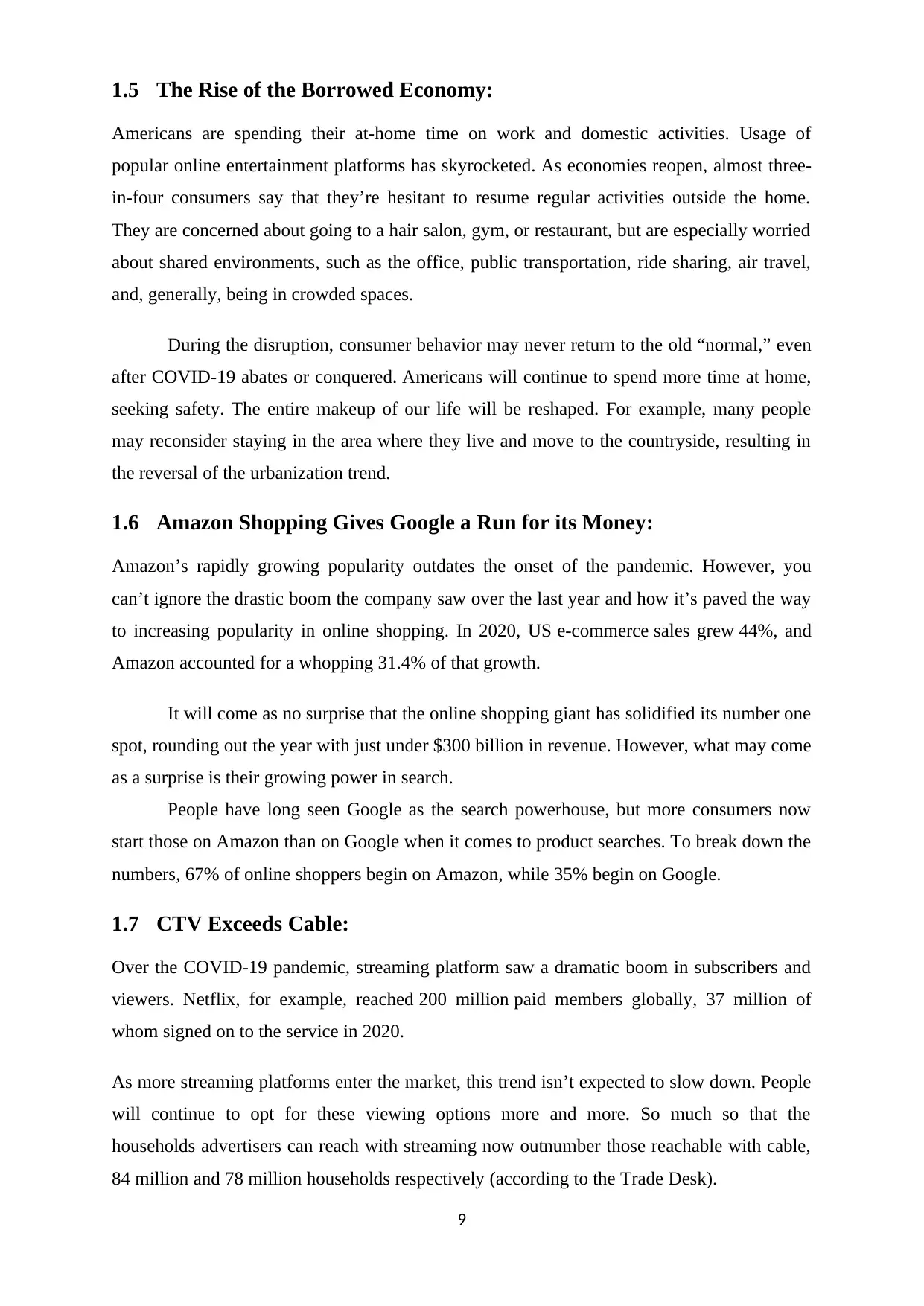
1.5 The Rise of the Borrowed Economy:
Americans are spending their at-home time on work and domestic activities. Usage of
popular online entertainment platforms has skyrocketed. As economies reopen, almost three-
in-four consumers say that they’re hesitant to resume regular activities outside the home.
They are concerned about going to a hair salon, gym, or restaurant, but are especially worried
about shared environments, such as the office, public transportation, ride sharing, air travel,
and, generally, being in crowded spaces.
During the disruption, consumer behavior may never return to the old “normal,” even
after COVID-19 abates or conquered. Americans will continue to spend more time at home,
seeking safety. The entire makeup of our life will be reshaped. For example, many people
may reconsider staying in the area where they live and move to the countryside, resulting in
the reversal of the urbanization trend.
1.6 Amazon Shopping Gives Google a Run for its Money:
Amazon’s rapidly growing popularity outdates the onset of the pandemic. However, you
can’t ignore the drastic boom the company saw over the last year and how it’s paved the way
to increasing popularity in online shopping. In 2020, US e-commerce sales grew 44%, and
Amazon accounted for a whopping 31.4% of that growth.
It will come as no surprise that the online shopping giant has solidified its number one
spot, rounding out the year with just under $300 billion in revenue. However, what may come
as a surprise is their growing power in search.
People have long seen Google as the search powerhouse, but more consumers now
start those on Amazon than on Google when it comes to product searches. To break down the
numbers, 67% of online shoppers begin on Amazon, while 35% begin on Google.
1.7 CTV Exceeds Cable:
Over the COVID-19 pandemic, streaming platform saw a dramatic boom in subscribers and
viewers. Netflix, for example, reached 200 million paid members globally, 37 million of
whom signed on to the service in 2020.
As more streaming platforms enter the market, this trend isn’t expected to slow down. People
will continue to opt for these viewing options more and more. So much so that the
households advertisers can reach with streaming now outnumber those reachable with cable,
84 million and 78 million households respectively (according to the Trade Desk).
9
Americans are spending their at-home time on work and domestic activities. Usage of
popular online entertainment platforms has skyrocketed. As economies reopen, almost three-
in-four consumers say that they’re hesitant to resume regular activities outside the home.
They are concerned about going to a hair salon, gym, or restaurant, but are especially worried
about shared environments, such as the office, public transportation, ride sharing, air travel,
and, generally, being in crowded spaces.
During the disruption, consumer behavior may never return to the old “normal,” even
after COVID-19 abates or conquered. Americans will continue to spend more time at home,
seeking safety. The entire makeup of our life will be reshaped. For example, many people
may reconsider staying in the area where they live and move to the countryside, resulting in
the reversal of the urbanization trend.
1.6 Amazon Shopping Gives Google a Run for its Money:
Amazon’s rapidly growing popularity outdates the onset of the pandemic. However, you
can’t ignore the drastic boom the company saw over the last year and how it’s paved the way
to increasing popularity in online shopping. In 2020, US e-commerce sales grew 44%, and
Amazon accounted for a whopping 31.4% of that growth.
It will come as no surprise that the online shopping giant has solidified its number one
spot, rounding out the year with just under $300 billion in revenue. However, what may come
as a surprise is their growing power in search.
People have long seen Google as the search powerhouse, but more consumers now
start those on Amazon than on Google when it comes to product searches. To break down the
numbers, 67% of online shoppers begin on Amazon, while 35% begin on Google.
1.7 CTV Exceeds Cable:
Over the COVID-19 pandemic, streaming platform saw a dramatic boom in subscribers and
viewers. Netflix, for example, reached 200 million paid members globally, 37 million of
whom signed on to the service in 2020.
As more streaming platforms enter the market, this trend isn’t expected to slow down. People
will continue to opt for these viewing options more and more. So much so that the
households advertisers can reach with streaming now outnumber those reachable with cable,
84 million and 78 million households respectively (according to the Trade Desk).
9
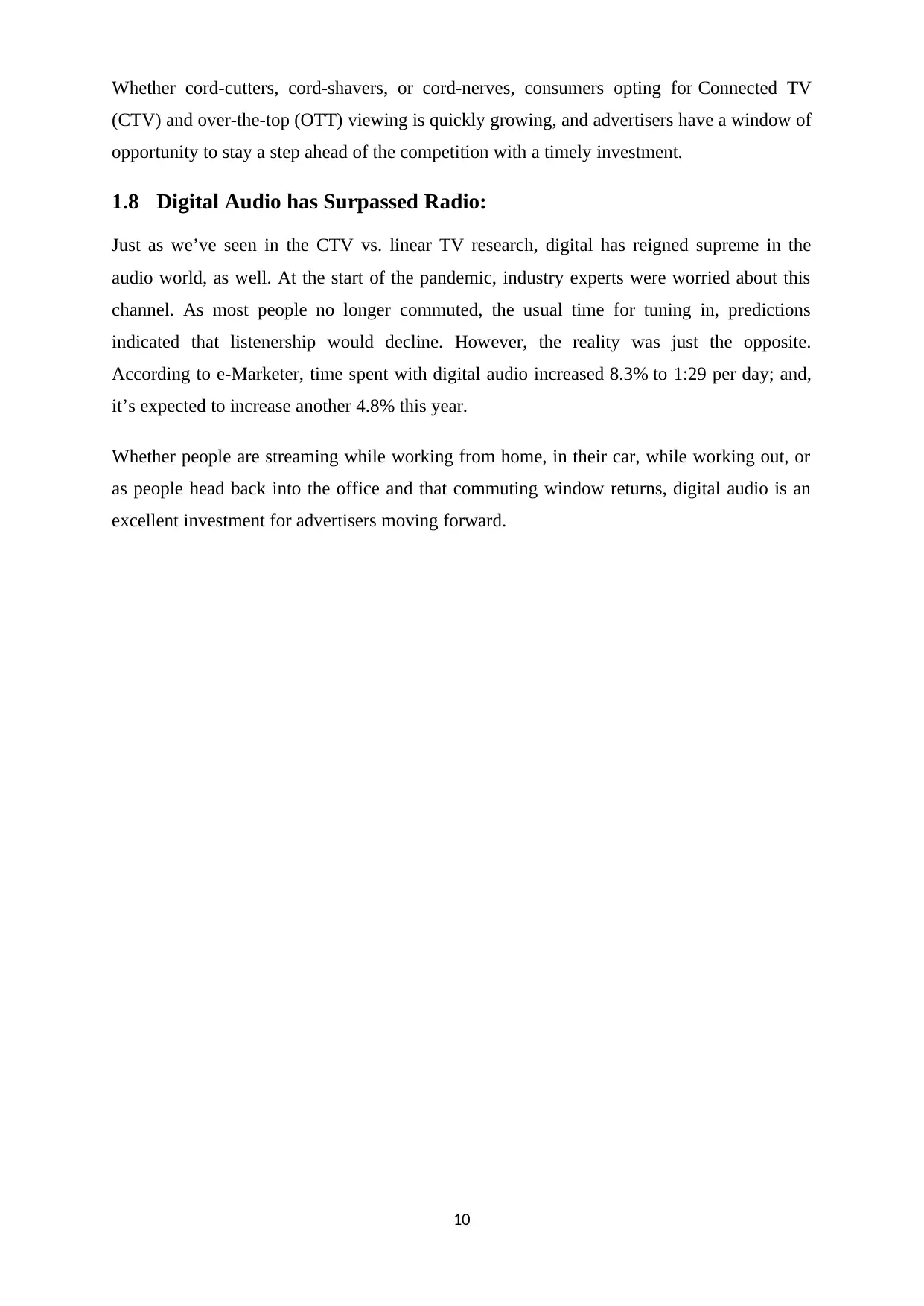
Whether cord-cutters, cord-shavers, or cord-nerves, consumers opting for Connected TV
(CTV) and over-the-top (OTT) viewing is quickly growing, and advertisers have a window of
opportunity to stay a step ahead of the competition with a timely investment.
1.8 Digital Audio has Surpassed Radio:
Just as we’ve seen in the CTV vs. linear TV research, digital has reigned supreme in the
audio world, as well. At the start of the pandemic, industry experts were worried about this
channel. As most people no longer commuted, the usual time for tuning in, predictions
indicated that listenership would decline. However, the reality was just the opposite.
According to e-Marketer, time spent with digital audio increased 8.3% to 1:29 per day; and,
it’s expected to increase another 4.8% this year.
Whether people are streaming while working from home, in their car, while working out, or
as people head back into the office and that commuting window returns, digital audio is an
excellent investment for advertisers moving forward.
10
(CTV) and over-the-top (OTT) viewing is quickly growing, and advertisers have a window of
opportunity to stay a step ahead of the competition with a timely investment.
1.8 Digital Audio has Surpassed Radio:
Just as we’ve seen in the CTV vs. linear TV research, digital has reigned supreme in the
audio world, as well. At the start of the pandemic, industry experts were worried about this
channel. As most people no longer commuted, the usual time for tuning in, predictions
indicated that listenership would decline. However, the reality was just the opposite.
According to e-Marketer, time spent with digital audio increased 8.3% to 1:29 per day; and,
it’s expected to increase another 4.8% this year.
Whether people are streaming while working from home, in their car, while working out, or
as people head back into the office and that commuting window returns, digital audio is an
excellent investment for advertisers moving forward.
10
Secure Best Marks with AI Grader
Need help grading? Try our AI Grader for instant feedback on your assignments.
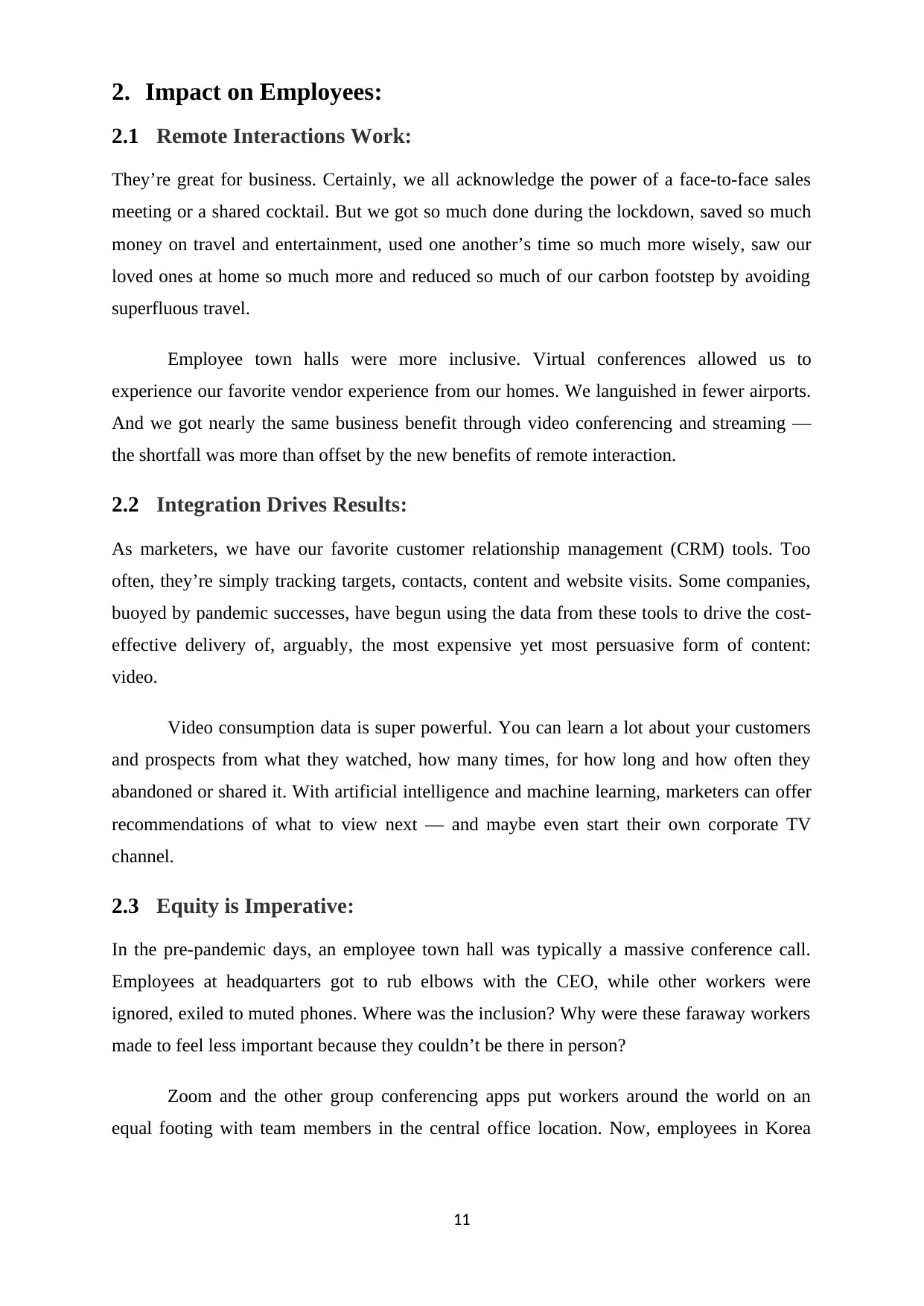
2. Impact on Employees:
2.1 Remote Interactions Work:
They’re great for business. Certainly, we all acknowledge the power of a face-to-face sales
meeting or a shared cocktail. But we got so much done during the lockdown, saved so much
money on travel and entertainment, used one another’s time so much more wisely, saw our
loved ones at home so much more and reduced so much of our carbon footstep by avoiding
superfluous travel.
Employee town halls were more inclusive. Virtual conferences allowed us to
experience our favorite vendor experience from our homes. We languished in fewer airports.
And we got nearly the same business benefit through video conferencing and streaming —
the shortfall was more than offset by the new benefits of remote interaction.
2.2 Integration Drives Results:
As marketers, we have our favorite customer relationship management (CRM) tools. Too
often, they’re simply tracking targets, contacts, content and website visits. Some companies,
buoyed by pandemic successes, have begun using the data from these tools to drive the cost-
effective delivery of, arguably, the most expensive yet most persuasive form of content:
video.
Video consumption data is super powerful. You can learn a lot about your customers
and prospects from what they watched, how many times, for how long and how often they
abandoned or shared it. With artificial intelligence and machine learning, marketers can offer
recommendations of what to view next — and maybe even start their own corporate TV
channel.
2.3 Equity is Imperative:
In the pre-pandemic days, an employee town hall was typically a massive conference call.
Employees at headquarters got to rub elbows with the CEO, while other workers were
ignored, exiled to muted phones. Where was the inclusion? Why were these faraway workers
made to feel less important because they couldn’t be there in person?
Zoom and the other group conferencing apps put workers around the world on an
equal footing with team members in the central office location. Now, employees in Korea
11
2.1 Remote Interactions Work:
They’re great for business. Certainly, we all acknowledge the power of a face-to-face sales
meeting or a shared cocktail. But we got so much done during the lockdown, saved so much
money on travel and entertainment, used one another’s time so much more wisely, saw our
loved ones at home so much more and reduced so much of our carbon footstep by avoiding
superfluous travel.
Employee town halls were more inclusive. Virtual conferences allowed us to
experience our favorite vendor experience from our homes. We languished in fewer airports.
And we got nearly the same business benefit through video conferencing and streaming —
the shortfall was more than offset by the new benefits of remote interaction.
2.2 Integration Drives Results:
As marketers, we have our favorite customer relationship management (CRM) tools. Too
often, they’re simply tracking targets, contacts, content and website visits. Some companies,
buoyed by pandemic successes, have begun using the data from these tools to drive the cost-
effective delivery of, arguably, the most expensive yet most persuasive form of content:
video.
Video consumption data is super powerful. You can learn a lot about your customers
and prospects from what they watched, how many times, for how long and how often they
abandoned or shared it. With artificial intelligence and machine learning, marketers can offer
recommendations of what to view next — and maybe even start their own corporate TV
channel.
2.3 Equity is Imperative:
In the pre-pandemic days, an employee town hall was typically a massive conference call.
Employees at headquarters got to rub elbows with the CEO, while other workers were
ignored, exiled to muted phones. Where was the inclusion? Why were these faraway workers
made to feel less important because they couldn’t be there in person?
Zoom and the other group conferencing apps put workers around the world on an
equal footing with team members in the central office location. Now, employees in Korea
11
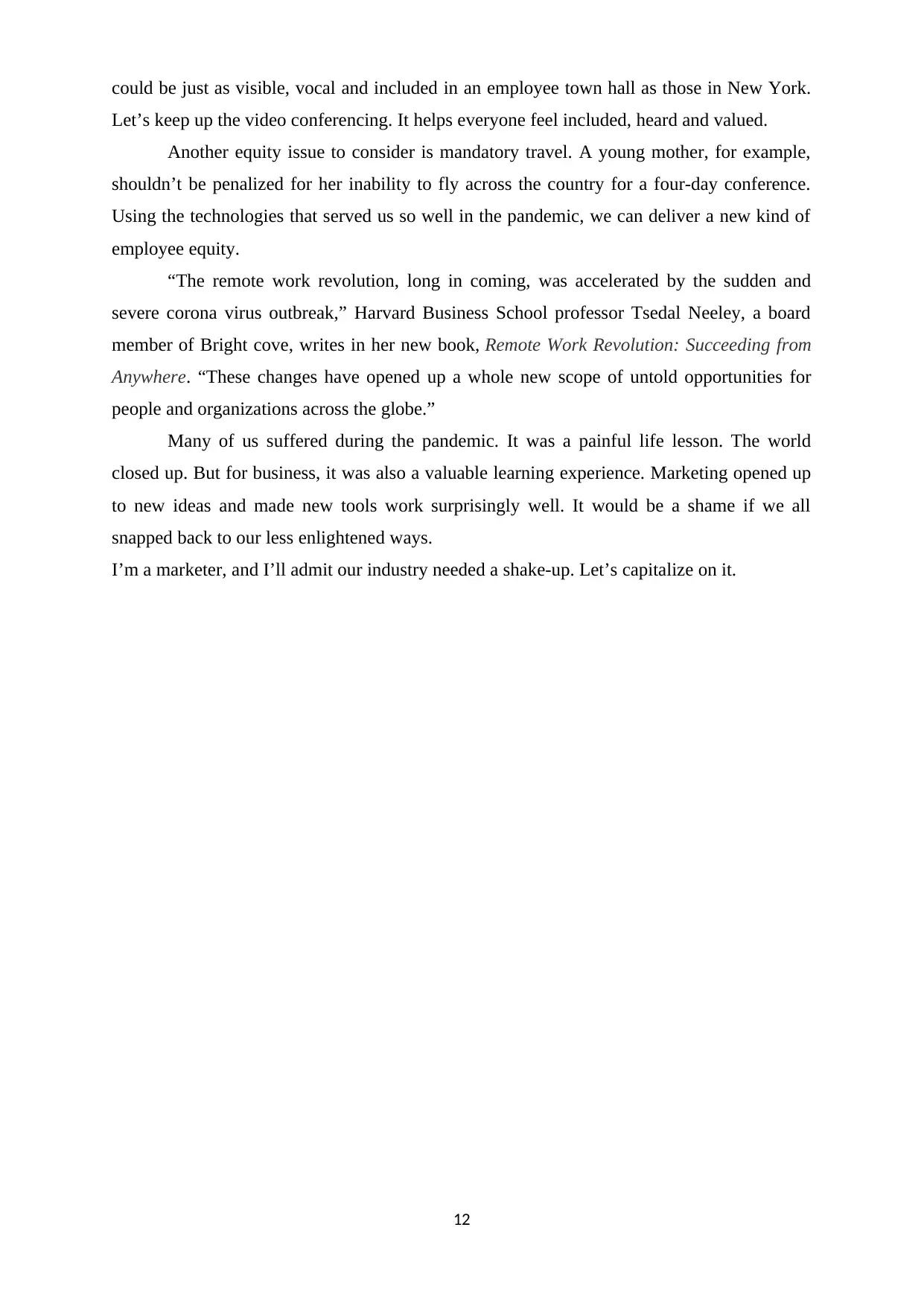
could be just as visible, vocal and included in an employee town hall as those in New York.
Let’s keep up the video conferencing. It helps everyone feel included, heard and valued.
Another equity issue to consider is mandatory travel. A young mother, for example,
shouldn’t be penalized for her inability to fly across the country for a four-day conference.
Using the technologies that served us so well in the pandemic, we can deliver a new kind of
employee equity.
“The remote work revolution, long in coming, was accelerated by the sudden and
severe corona virus outbreak,” Harvard Business School professor Tsedal Neeley, a board
member of Bright cove, writes in her new book, Remote Work Revolution: Succeeding from
Anywhere. “These changes have opened up a whole new scope of untold opportunities for
people and organizations across the globe.”
Many of us suffered during the pandemic. It was a painful life lesson. The world
closed up. But for business, it was also a valuable learning experience. Marketing opened up
to new ideas and made new tools work surprisingly well. It would be a shame if we all
snapped back to our less enlightened ways.
I’m a marketer, and I’ll admit our industry needed a shake-up. Let’s capitalize on it.
12
Let’s keep up the video conferencing. It helps everyone feel included, heard and valued.
Another equity issue to consider is mandatory travel. A young mother, for example,
shouldn’t be penalized for her inability to fly across the country for a four-day conference.
Using the technologies that served us so well in the pandemic, we can deliver a new kind of
employee equity.
“The remote work revolution, long in coming, was accelerated by the sudden and
severe corona virus outbreak,” Harvard Business School professor Tsedal Neeley, a board
member of Bright cove, writes in her new book, Remote Work Revolution: Succeeding from
Anywhere. “These changes have opened up a whole new scope of untold opportunities for
people and organizations across the globe.”
Many of us suffered during the pandemic. It was a painful life lesson. The world
closed up. But for business, it was also a valuable learning experience. Marketing opened up
to new ideas and made new tools work surprisingly well. It would be a shame if we all
snapped back to our less enlightened ways.
I’m a marketer, and I’ll admit our industry needed a shake-up. Let’s capitalize on it.
12
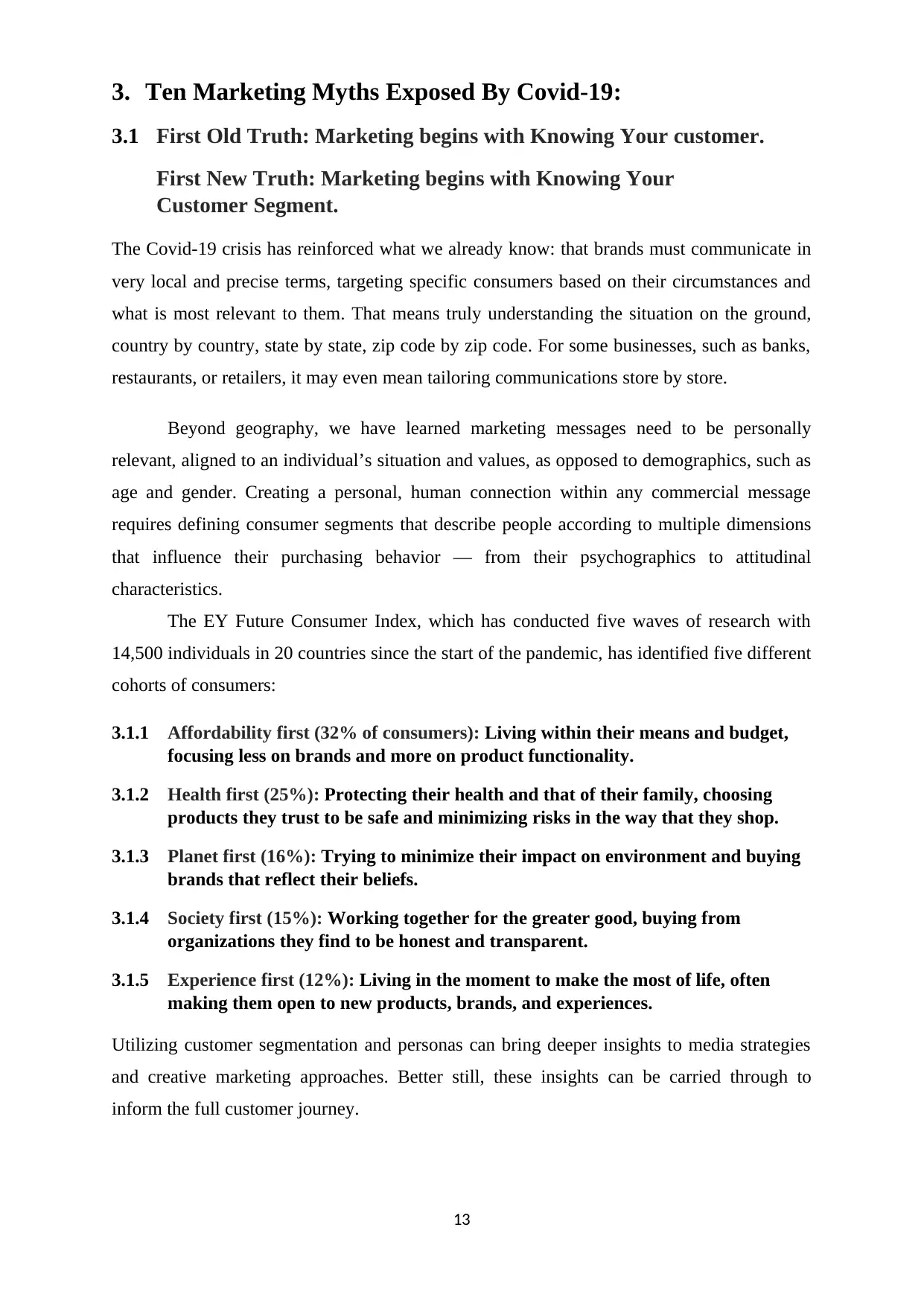
3. Ten Marketing Myths Exposed By Covid-19:
3.1 First Old Truth: Marketing begins with Knowing Your customer.
First New Truth: Marketing begins with Knowing Your
Customer Segment.
The Covid-19 crisis has reinforced what we already know: that brands must communicate in
very local and precise terms, targeting specific consumers based on their circumstances and
what is most relevant to them. That means truly understanding the situation on the ground,
country by country, state by state, zip code by zip code. For some businesses, such as banks,
restaurants, or retailers, it may even mean tailoring communications store by store.
Beyond geography, we have learned marketing messages need to be personally
relevant, aligned to an individual’s situation and values, as opposed to demographics, such as
age and gender. Creating a personal, human connection within any commercial message
requires defining consumer segments that describe people according to multiple dimensions
that influence their purchasing behavior — from their psychographics to attitudinal
characteristics.
The EY Future Consumer Index, which has conducted five waves of research with
14,500 individuals in 20 countries since the start of the pandemic, has identified five different
cohorts of consumers:
3.1.1 Affordability first (32% of consumers): Living within their means and budget,
focusing less on brands and more on product functionality.
3.1.2 Health first (25%): Protecting their health and that of their family, choosing
products they trust to be safe and minimizing risks in the way that they shop.
3.1.3 Planet first (16%): Trying to minimize their impact on environment and buying
brands that reflect their beliefs.
3.1.4 Society first (15%): Working together for the greater good, buying from
organizations they find to be honest and transparent.
3.1.5 Experience first (12%): Living in the moment to make the most of life, often
making them open to new products, brands, and experiences.
Utilizing customer segmentation and personas can bring deeper insights to media strategies
and creative marketing approaches. Better still, these insights can be carried through to
inform the full customer journey.
13
3.1 First Old Truth: Marketing begins with Knowing Your customer.
First New Truth: Marketing begins with Knowing Your
Customer Segment.
The Covid-19 crisis has reinforced what we already know: that brands must communicate in
very local and precise terms, targeting specific consumers based on their circumstances and
what is most relevant to them. That means truly understanding the situation on the ground,
country by country, state by state, zip code by zip code. For some businesses, such as banks,
restaurants, or retailers, it may even mean tailoring communications store by store.
Beyond geography, we have learned marketing messages need to be personally
relevant, aligned to an individual’s situation and values, as opposed to demographics, such as
age and gender. Creating a personal, human connection within any commercial message
requires defining consumer segments that describe people according to multiple dimensions
that influence their purchasing behavior — from their psychographics to attitudinal
characteristics.
The EY Future Consumer Index, which has conducted five waves of research with
14,500 individuals in 20 countries since the start of the pandemic, has identified five different
cohorts of consumers:
3.1.1 Affordability first (32% of consumers): Living within their means and budget,
focusing less on brands and more on product functionality.
3.1.2 Health first (25%): Protecting their health and that of their family, choosing
products they trust to be safe and minimizing risks in the way that they shop.
3.1.3 Planet first (16%): Trying to minimize their impact on environment and buying
brands that reflect their beliefs.
3.1.4 Society first (15%): Working together for the greater good, buying from
organizations they find to be honest and transparent.
3.1.5 Experience first (12%): Living in the moment to make the most of life, often
making them open to new products, brands, and experiences.
Utilizing customer segmentation and personas can bring deeper insights to media strategies
and creative marketing approaches. Better still, these insights can be carried through to
inform the full customer journey.
13
Paraphrase This Document
Need a fresh take? Get an instant paraphrase of this document with our AI Paraphraser
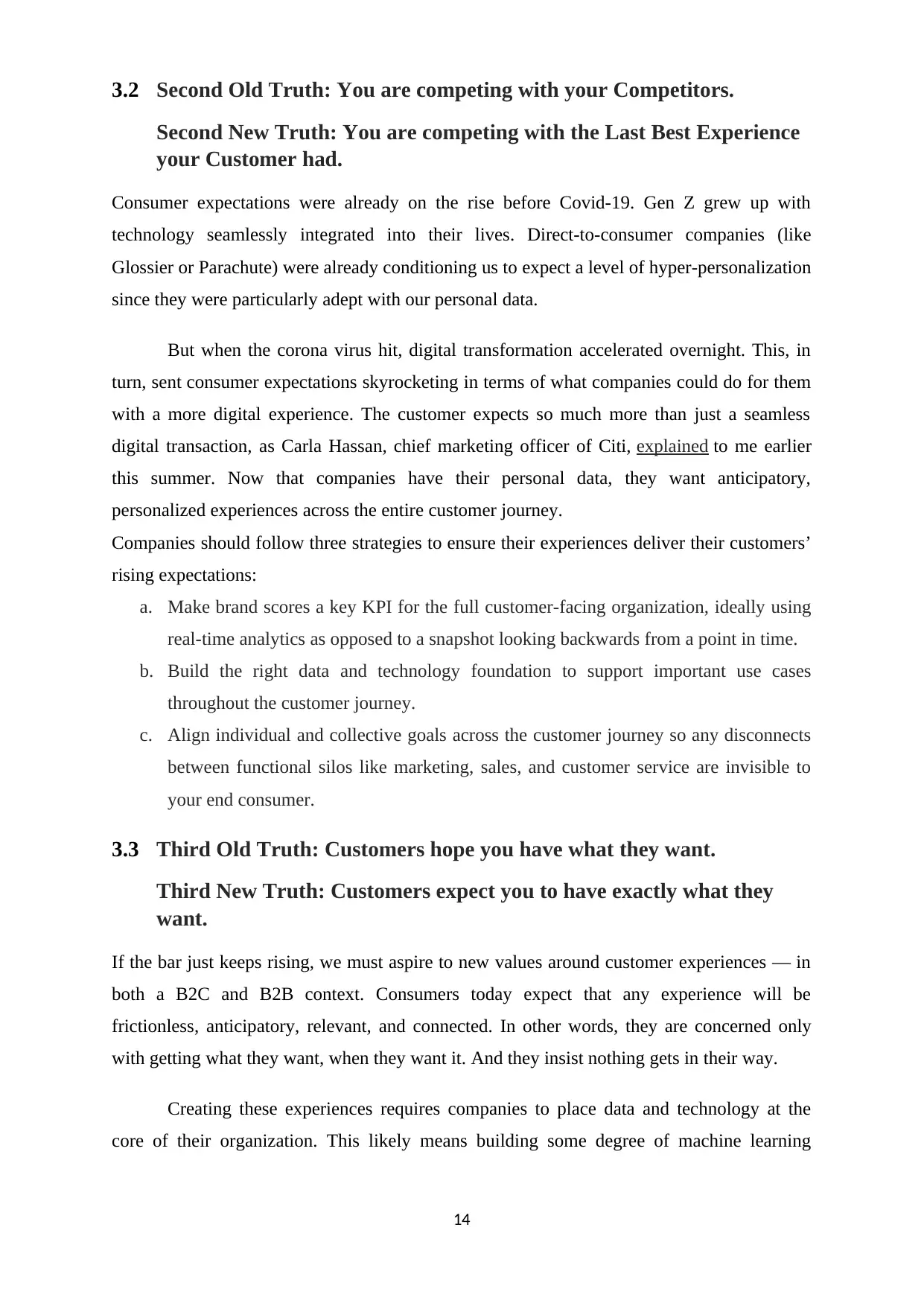
3.2 Second Old Truth: You are competing with your Competitors.
Second New Truth: You are competing with the Last Best Experience
your Customer had.
Consumer expectations were already on the rise before Covid-19. Gen Z grew up with
technology seamlessly integrated into their lives. Direct-to-consumer companies (like
Glossier or Parachute) were already conditioning us to expect a level of hyper-personalization
since they were particularly adept with our personal data.
But when the corona virus hit, digital transformation accelerated overnight. This, in
turn, sent consumer expectations skyrocketing in terms of what companies could do for them
with a more digital experience. The customer expects so much more than just a seamless
digital transaction, as Carla Hassan, chief marketing officer of Citi, explained to me earlier
this summer. Now that companies have their personal data, they want anticipatory,
personalized experiences across the entire customer journey.
Companies should follow three strategies to ensure their experiences deliver their customers’
rising expectations:
a. Make brand scores a key KPI for the full customer-facing organization, ideally using
real-time analytics as opposed to a snapshot looking backwards from a point in time.
b. Build the right data and technology foundation to support important use cases
throughout the customer journey.
c. Align individual and collective goals across the customer journey so any disconnects
between functional silos like marketing, sales, and customer service are invisible to
your end consumer.
3.3 Third Old Truth: Customers hope you have what they want.
Third New Truth: Customers expect you to have exactly what they
want.
If the bar just keeps rising, we must aspire to new values around customer experiences — in
both a B2C and B2B context. Consumers today expect that any experience will be
frictionless, anticipatory, relevant, and connected. In other words, they are concerned only
with getting what they want, when they want it. And they insist nothing gets in their way.
Creating these experiences requires companies to place data and technology at the
core of their organization. This likely means building some degree of machine learning
14
Second New Truth: You are competing with the Last Best Experience
your Customer had.
Consumer expectations were already on the rise before Covid-19. Gen Z grew up with
technology seamlessly integrated into their lives. Direct-to-consumer companies (like
Glossier or Parachute) were already conditioning us to expect a level of hyper-personalization
since they were particularly adept with our personal data.
But when the corona virus hit, digital transformation accelerated overnight. This, in
turn, sent consumer expectations skyrocketing in terms of what companies could do for them
with a more digital experience. The customer expects so much more than just a seamless
digital transaction, as Carla Hassan, chief marketing officer of Citi, explained to me earlier
this summer. Now that companies have their personal data, they want anticipatory,
personalized experiences across the entire customer journey.
Companies should follow three strategies to ensure their experiences deliver their customers’
rising expectations:
a. Make brand scores a key KPI for the full customer-facing organization, ideally using
real-time analytics as opposed to a snapshot looking backwards from a point in time.
b. Build the right data and technology foundation to support important use cases
throughout the customer journey.
c. Align individual and collective goals across the customer journey so any disconnects
between functional silos like marketing, sales, and customer service are invisible to
your end consumer.
3.3 Third Old Truth: Customers hope you have what they want.
Third New Truth: Customers expect you to have exactly what they
want.
If the bar just keeps rising, we must aspire to new values around customer experiences — in
both a B2C and B2B context. Consumers today expect that any experience will be
frictionless, anticipatory, relevant, and connected. In other words, they are concerned only
with getting what they want, when they want it. And they insist nothing gets in their way.
Creating these experiences requires companies to place data and technology at the
core of their organization. This likely means building some degree of machine learning
14
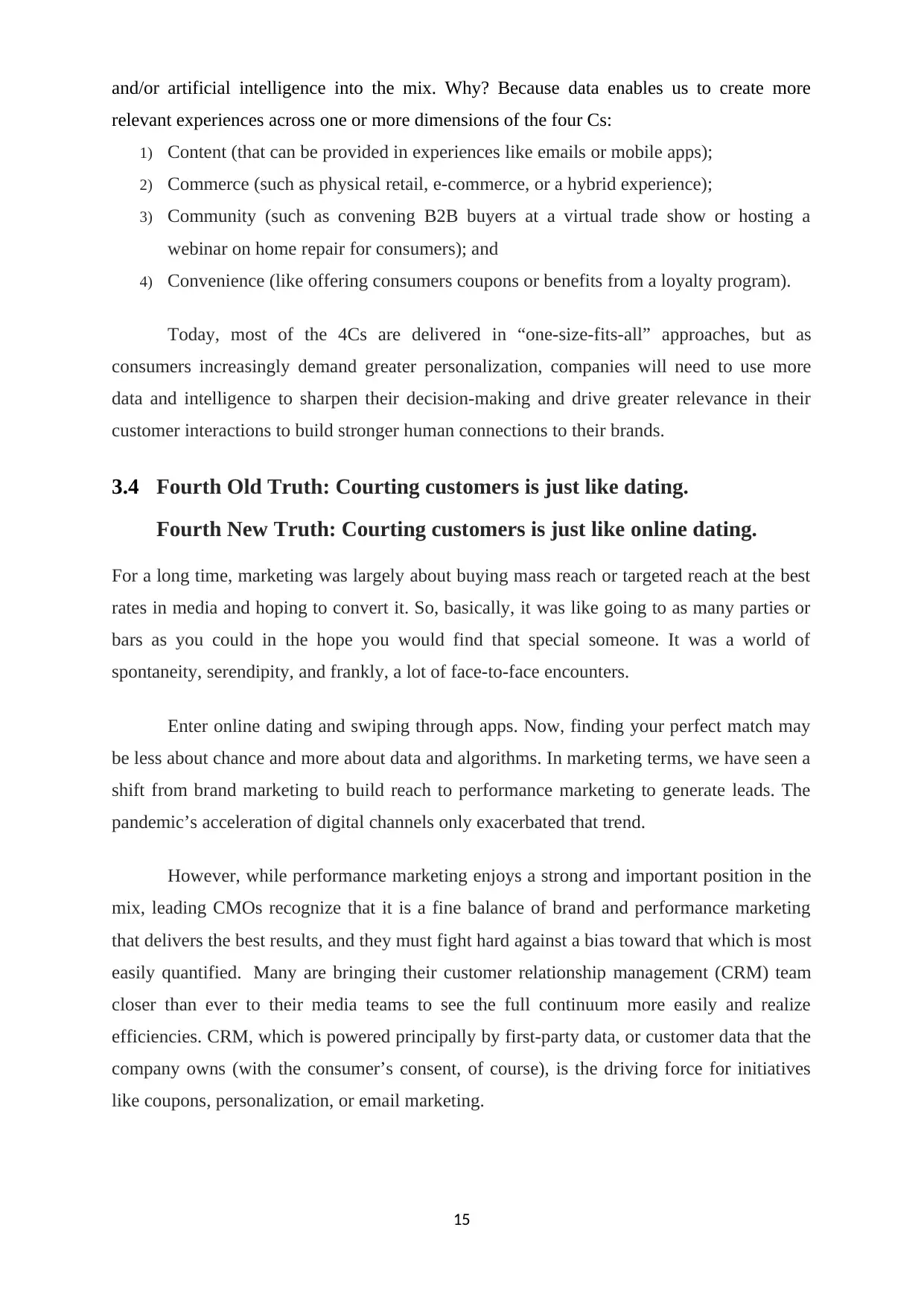
and/or artificial intelligence into the mix. Why? Because data enables us to create more
relevant experiences across one or more dimensions of the four Cs:
1) Content (that can be provided in experiences like emails or mobile apps);
2) Commerce (such as physical retail, e-commerce, or a hybrid experience);
3) Community (such as convening B2B buyers at a virtual trade show or hosting a
webinar on home repair for consumers); and
4) Convenience (like offering consumers coupons or benefits from a loyalty program).
Today, most of the 4Cs are delivered in “one-size-fits-all” approaches, but as
consumers increasingly demand greater personalization, companies will need to use more
data and intelligence to sharpen their decision-making and drive greater relevance in their
customer interactions to build stronger human connections to their brands.
3.4 Fourth Old Truth: Courting customers is just like dating.
Fourth New Truth: Courting customers is just like online dating.
For a long time, marketing was largely about buying mass reach or targeted reach at the best
rates in media and hoping to convert it. So, basically, it was like going to as many parties or
bars as you could in the hope you would find that special someone. It was a world of
spontaneity, serendipity, and frankly, a lot of face-to-face encounters.
Enter online dating and swiping through apps. Now, finding your perfect match may
be less about chance and more about data and algorithms. In marketing terms, we have seen a
shift from brand marketing to build reach to performance marketing to generate leads. The
pandemic’s acceleration of digital channels only exacerbated that trend.
However, while performance marketing enjoys a strong and important position in the
mix, leading CMOs recognize that it is a fine balance of brand and performance marketing
that delivers the best results, and they must fight hard against a bias toward that which is most
easily quantified. Many are bringing their customer relationship management (CRM) team
closer than ever to their media teams to see the full continuum more easily and realize
efficiencies. CRM, which is powered principally by first-party data, or customer data that the
company owns (with the consumer’s consent, of course), is the driving force for initiatives
like coupons, personalization, or email marketing.
15
relevant experiences across one or more dimensions of the four Cs:
1) Content (that can be provided in experiences like emails or mobile apps);
2) Commerce (such as physical retail, e-commerce, or a hybrid experience);
3) Community (such as convening B2B buyers at a virtual trade show or hosting a
webinar on home repair for consumers); and
4) Convenience (like offering consumers coupons or benefits from a loyalty program).
Today, most of the 4Cs are delivered in “one-size-fits-all” approaches, but as
consumers increasingly demand greater personalization, companies will need to use more
data and intelligence to sharpen their decision-making and drive greater relevance in their
customer interactions to build stronger human connections to their brands.
3.4 Fourth Old Truth: Courting customers is just like dating.
Fourth New Truth: Courting customers is just like online dating.
For a long time, marketing was largely about buying mass reach or targeted reach at the best
rates in media and hoping to convert it. So, basically, it was like going to as many parties or
bars as you could in the hope you would find that special someone. It was a world of
spontaneity, serendipity, and frankly, a lot of face-to-face encounters.
Enter online dating and swiping through apps. Now, finding your perfect match may
be less about chance and more about data and algorithms. In marketing terms, we have seen a
shift from brand marketing to build reach to performance marketing to generate leads. The
pandemic’s acceleration of digital channels only exacerbated that trend.
However, while performance marketing enjoys a strong and important position in the
mix, leading CMOs recognize that it is a fine balance of brand and performance marketing
that delivers the best results, and they must fight hard against a bias toward that which is most
easily quantified. Many are bringing their customer relationship management (CRM) team
closer than ever to their media teams to see the full continuum more easily and realize
efficiencies. CRM, which is powered principally by first-party data, or customer data that the
company owns (with the consumer’s consent, of course), is the driving force for initiatives
like coupons, personalization, or email marketing.
15
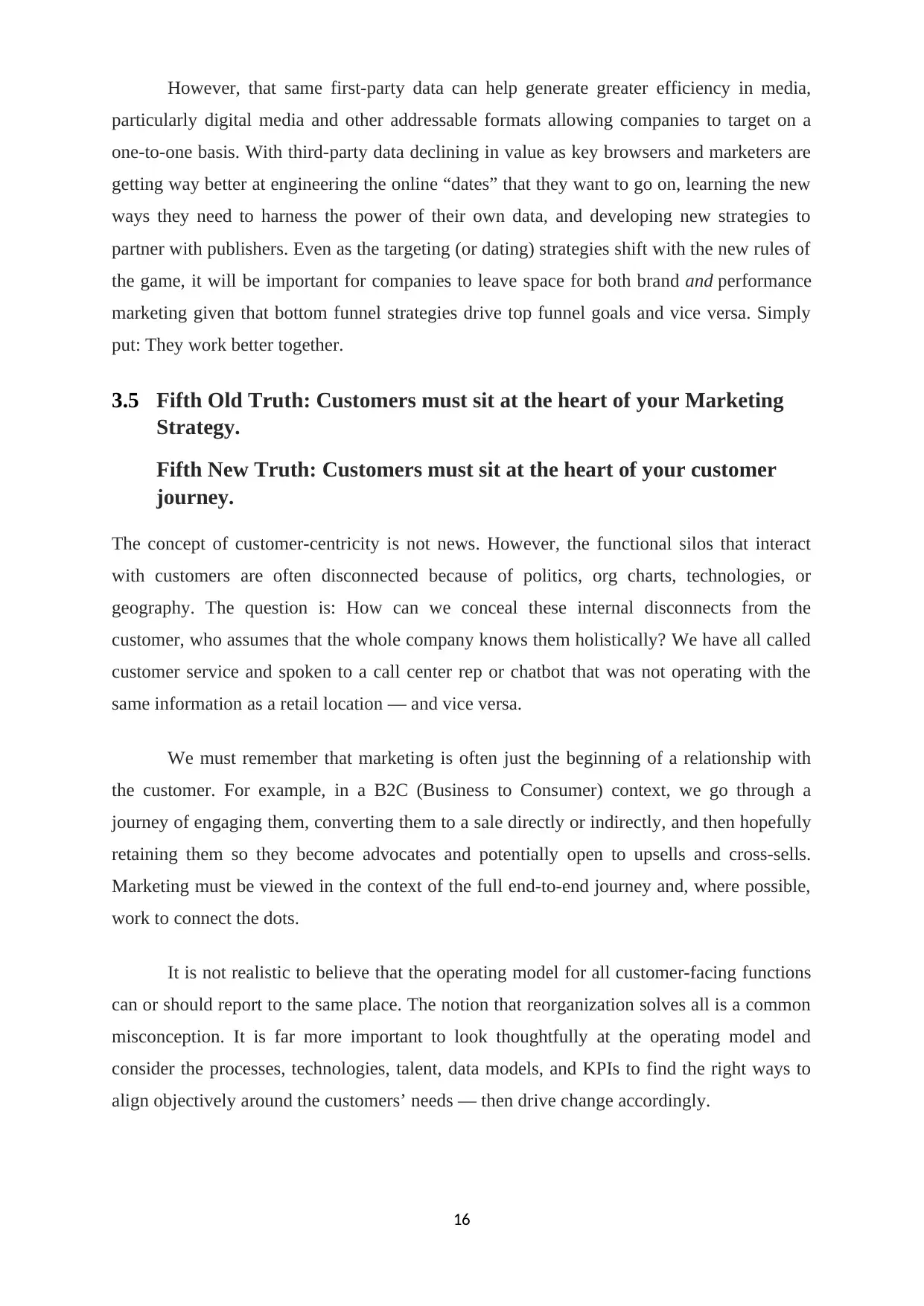
However, that same first-party data can help generate greater efficiency in media,
particularly digital media and other addressable formats allowing companies to target on a
one-to-one basis. With third-party data declining in value as key browsers and marketers are
getting way better at engineering the online “dates” that they want to go on, learning the new
ways they need to harness the power of their own data, and developing new strategies to
partner with publishers. Even as the targeting (or dating) strategies shift with the new rules of
the game, it will be important for companies to leave space for both brand and performance
marketing given that bottom funnel strategies drive top funnel goals and vice versa. Simply
put: They work better together.
3.5 Fifth Old Truth: Customers must sit at the heart of your Marketing
Strategy.
Fifth New Truth: Customers must sit at the heart of your customer
journey.
The concept of customer-centricity is not news. However, the functional silos that interact
with customers are often disconnected because of politics, org charts, technologies, or
geography. The question is: How can we conceal these internal disconnects from the
customer, who assumes that the whole company knows them holistically? We have all called
customer service and spoken to a call center rep or chatbot that was not operating with the
same information as a retail location — and vice versa.
We must remember that marketing is often just the beginning of a relationship with
the customer. For example, in a B2C (Business to Consumer) context, we go through a
journey of engaging them, converting them to a sale directly or indirectly, and then hopefully
retaining them so they become advocates and potentially open to upsells and cross-sells.
Marketing must be viewed in the context of the full end-to-end journey and, where possible,
work to connect the dots.
It is not realistic to believe that the operating model for all customer-facing functions
can or should report to the same place. The notion that reorganization solves all is a common
misconception. It is far more important to look thoughtfully at the operating model and
consider the processes, technologies, talent, data models, and KPIs to find the right ways to
align objectively around the customers’ needs — then drive change accordingly.
16
particularly digital media and other addressable formats allowing companies to target on a
one-to-one basis. With third-party data declining in value as key browsers and marketers are
getting way better at engineering the online “dates” that they want to go on, learning the new
ways they need to harness the power of their own data, and developing new strategies to
partner with publishers. Even as the targeting (or dating) strategies shift with the new rules of
the game, it will be important for companies to leave space for both brand and performance
marketing given that bottom funnel strategies drive top funnel goals and vice versa. Simply
put: They work better together.
3.5 Fifth Old Truth: Customers must sit at the heart of your Marketing
Strategy.
Fifth New Truth: Customers must sit at the heart of your customer
journey.
The concept of customer-centricity is not news. However, the functional silos that interact
with customers are often disconnected because of politics, org charts, technologies, or
geography. The question is: How can we conceal these internal disconnects from the
customer, who assumes that the whole company knows them holistically? We have all called
customer service and spoken to a call center rep or chatbot that was not operating with the
same information as a retail location — and vice versa.
We must remember that marketing is often just the beginning of a relationship with
the customer. For example, in a B2C (Business to Consumer) context, we go through a
journey of engaging them, converting them to a sale directly or indirectly, and then hopefully
retaining them so they become advocates and potentially open to upsells and cross-sells.
Marketing must be viewed in the context of the full end-to-end journey and, where possible,
work to connect the dots.
It is not realistic to believe that the operating model for all customer-facing functions
can or should report to the same place. The notion that reorganization solves all is a common
misconception. It is far more important to look thoughtfully at the operating model and
consider the processes, technologies, talent, data models, and KPIs to find the right ways to
align objectively around the customers’ needs — then drive change accordingly.
16
Secure Best Marks with AI Grader
Need help grading? Try our AI Grader for instant feedback on your assignments.
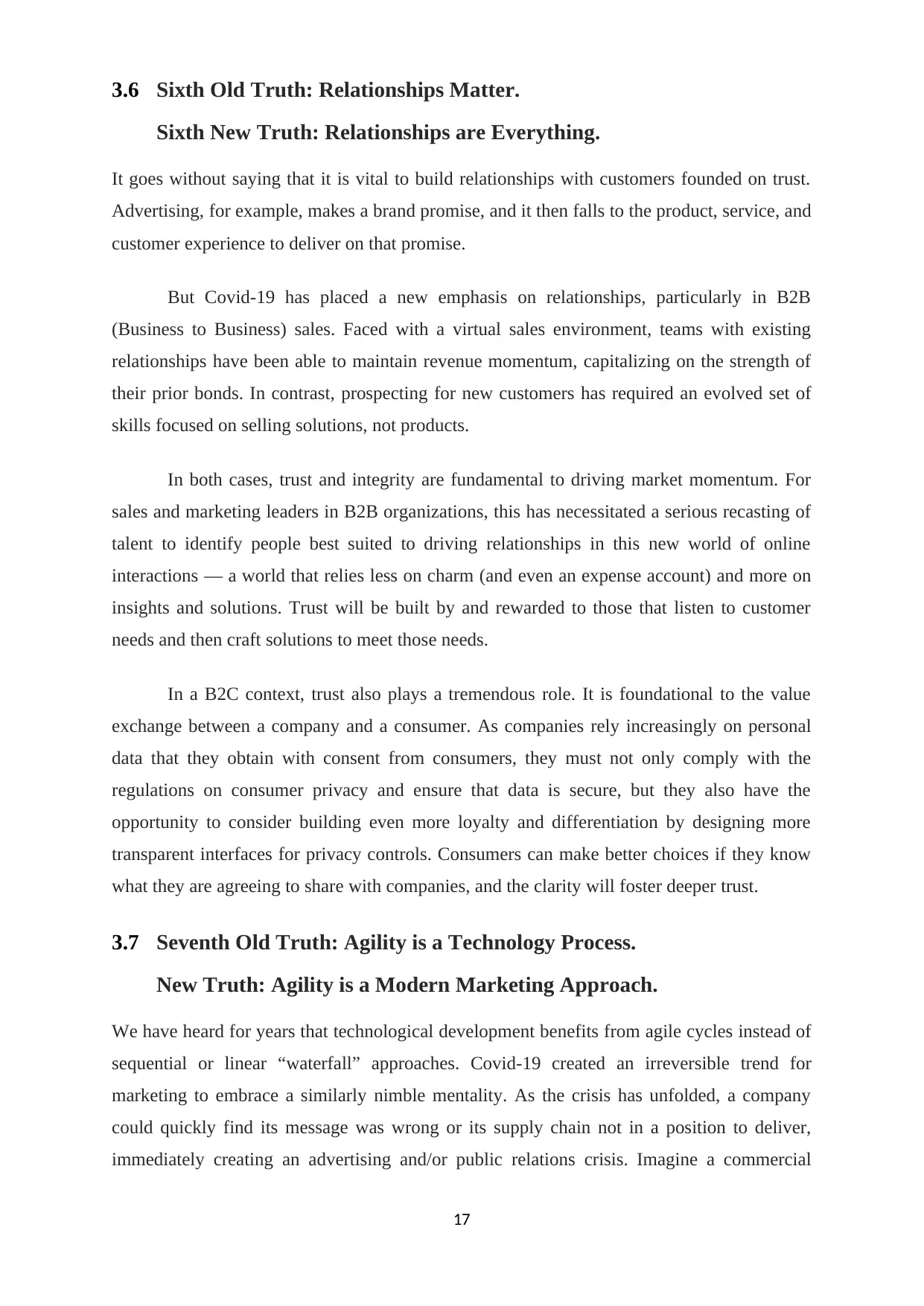
3.6 Sixth Old Truth: Relationships Matter.
Sixth New Truth: Relationships are Everything.
It goes without saying that it is vital to build relationships with customers founded on trust.
Advertising, for example, makes a brand promise, and it then falls to the product, service, and
customer experience to deliver on that promise.
But Covid-19 has placed a new emphasis on relationships, particularly in B2B
(Business to Business) sales. Faced with a virtual sales environment, teams with existing
relationships have been able to maintain revenue momentum, capitalizing on the strength of
their prior bonds. In contrast, prospecting for new customers has required an evolved set of
skills focused on selling solutions, not products.
In both cases, trust and integrity are fundamental to driving market momentum. For
sales and marketing leaders in B2B organizations, this has necessitated a serious recasting of
talent to identify people best suited to driving relationships in this new world of online
interactions — a world that relies less on charm (and even an expense account) and more on
insights and solutions. Trust will be built by and rewarded to those that listen to customer
needs and then craft solutions to meet those needs.
In a B2C context, trust also plays a tremendous role. It is foundational to the value
exchange between a company and a consumer. As companies rely increasingly on personal
data that they obtain with consent from consumers, they must not only comply with the
regulations on consumer privacy and ensure that data is secure, but they also have the
opportunity to consider building even more loyalty and differentiation by designing more
transparent interfaces for privacy controls. Consumers can make better choices if they know
what they are agreeing to share with companies, and the clarity will foster deeper trust.
3.7 Seventh Old Truth: Agility is a Technology Process.
New Truth: Agility is a Modern Marketing Approach.
We have heard for years that technological development benefits from agile cycles instead of
sequential or linear “waterfall” approaches. Covid-19 created an irreversible trend for
marketing to embrace a similarly nimble mentality. As the crisis has unfolded, a company
could quickly find its message was wrong or its supply chain not in a position to deliver,
immediately creating an advertising and/or public relations crisis. Imagine a commercial
17
Sixth New Truth: Relationships are Everything.
It goes without saying that it is vital to build relationships with customers founded on trust.
Advertising, for example, makes a brand promise, and it then falls to the product, service, and
customer experience to deliver on that promise.
But Covid-19 has placed a new emphasis on relationships, particularly in B2B
(Business to Business) sales. Faced with a virtual sales environment, teams with existing
relationships have been able to maintain revenue momentum, capitalizing on the strength of
their prior bonds. In contrast, prospecting for new customers has required an evolved set of
skills focused on selling solutions, not products.
In both cases, trust and integrity are fundamental to driving market momentum. For
sales and marketing leaders in B2B organizations, this has necessitated a serious recasting of
talent to identify people best suited to driving relationships in this new world of online
interactions — a world that relies less on charm (and even an expense account) and more on
insights and solutions. Trust will be built by and rewarded to those that listen to customer
needs and then craft solutions to meet those needs.
In a B2C context, trust also plays a tremendous role. It is foundational to the value
exchange between a company and a consumer. As companies rely increasingly on personal
data that they obtain with consent from consumers, they must not only comply with the
regulations on consumer privacy and ensure that data is secure, but they also have the
opportunity to consider building even more loyalty and differentiation by designing more
transparent interfaces for privacy controls. Consumers can make better choices if they know
what they are agreeing to share with companies, and the clarity will foster deeper trust.
3.7 Seventh Old Truth: Agility is a Technology Process.
New Truth: Agility is a Modern Marketing Approach.
We have heard for years that technological development benefits from agile cycles instead of
sequential or linear “waterfall” approaches. Covid-19 created an irreversible trend for
marketing to embrace a similarly nimble mentality. As the crisis has unfolded, a company
could quickly find its message was wrong or its supply chain not in a position to deliver,
immediately creating an advertising and/or public relations crisis. Imagine a commercial
17
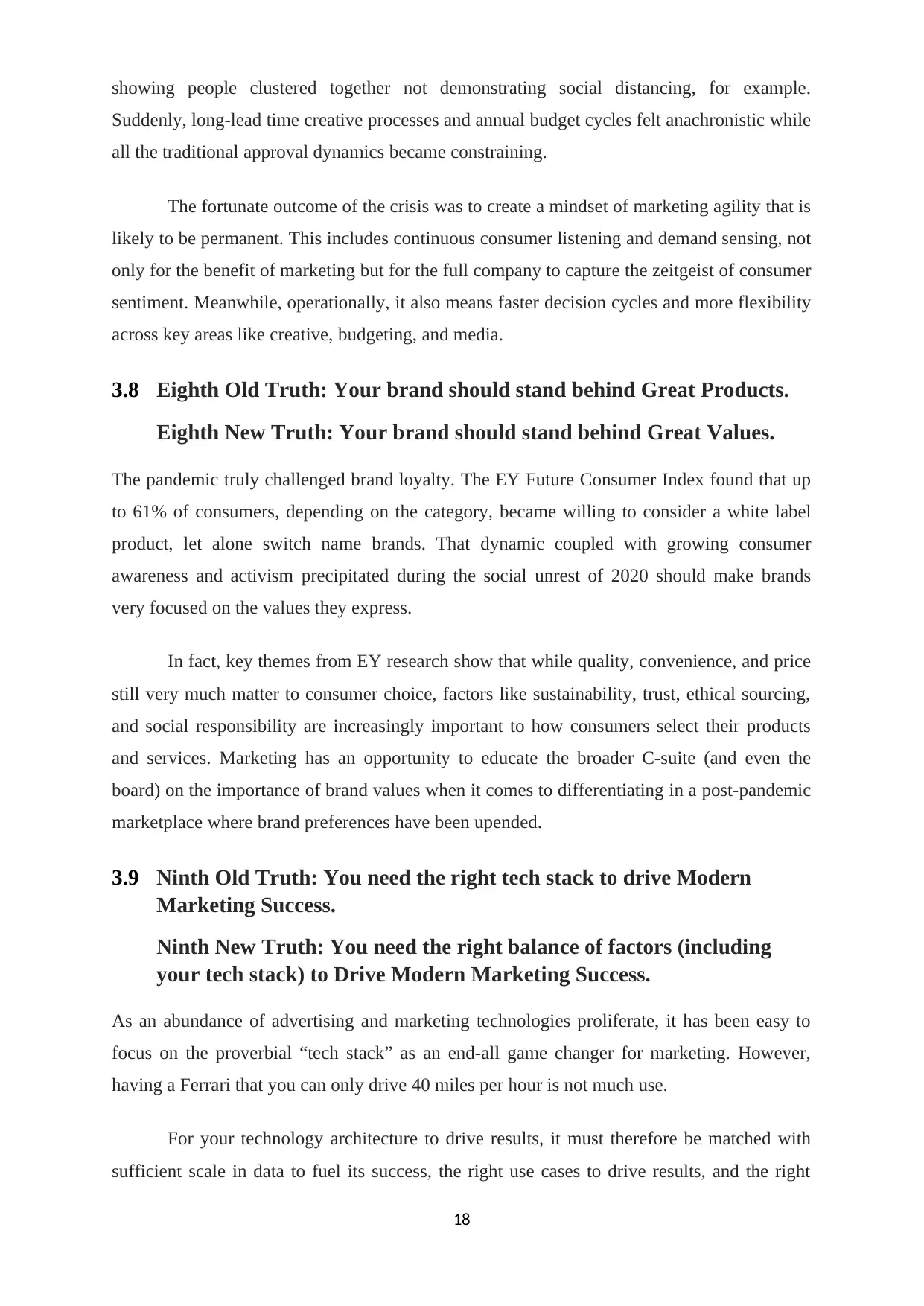
showing people clustered together not demonstrating social distancing, for example.
Suddenly, long-lead time creative processes and annual budget cycles felt anachronistic while
all the traditional approval dynamics became constraining.
The fortunate outcome of the crisis was to create a mindset of marketing agility that is
likely to be permanent. This includes continuous consumer listening and demand sensing, not
only for the benefit of marketing but for the full company to capture the zeitgeist of consumer
sentiment. Meanwhile, operationally, it also means faster decision cycles and more flexibility
across key areas like creative, budgeting, and media.
3.8 Eighth Old Truth: Your brand should stand behind Great Products.
Eighth New Truth: Your brand should stand behind Great Values.
The pandemic truly challenged brand loyalty. The EY Future Consumer Index found that up
to 61% of consumers, depending on the category, became willing to consider a white label
product, let alone switch name brands. That dynamic coupled with growing consumer
awareness and activism precipitated during the social unrest of 2020 should make brands
very focused on the values they express.
In fact, key themes from EY research show that while quality, convenience, and price
still very much matter to consumer choice, factors like sustainability, trust, ethical sourcing,
and social responsibility are increasingly important to how consumers select their products
and services. Marketing has an opportunity to educate the broader C-suite (and even the
board) on the importance of brand values when it comes to differentiating in a post-pandemic
marketplace where brand preferences have been upended.
3.9 Ninth Old Truth: You need the right tech stack to drive Modern
Marketing Success.
Ninth New Truth: You need the right balance of factors (including
your tech stack) to Drive Modern Marketing Success.
As an abundance of advertising and marketing technologies proliferate, it has been easy to
focus on the proverbial “tech stack” as an end-all game changer for marketing. However,
having a Ferrari that you can only drive 40 miles per hour is not much use.
For your technology architecture to drive results, it must therefore be matched with
sufficient scale in data to fuel its success, the right use cases to drive results, and the right
18
Suddenly, long-lead time creative processes and annual budget cycles felt anachronistic while
all the traditional approval dynamics became constraining.
The fortunate outcome of the crisis was to create a mindset of marketing agility that is
likely to be permanent. This includes continuous consumer listening and demand sensing, not
only for the benefit of marketing but for the full company to capture the zeitgeist of consumer
sentiment. Meanwhile, operationally, it also means faster decision cycles and more flexibility
across key areas like creative, budgeting, and media.
3.8 Eighth Old Truth: Your brand should stand behind Great Products.
Eighth New Truth: Your brand should stand behind Great Values.
The pandemic truly challenged brand loyalty. The EY Future Consumer Index found that up
to 61% of consumers, depending on the category, became willing to consider a white label
product, let alone switch name brands. That dynamic coupled with growing consumer
awareness and activism precipitated during the social unrest of 2020 should make brands
very focused on the values they express.
In fact, key themes from EY research show that while quality, convenience, and price
still very much matter to consumer choice, factors like sustainability, trust, ethical sourcing,
and social responsibility are increasingly important to how consumers select their products
and services. Marketing has an opportunity to educate the broader C-suite (and even the
board) on the importance of brand values when it comes to differentiating in a post-pandemic
marketplace where brand preferences have been upended.
3.9 Ninth Old Truth: You need the right tech stack to drive Modern
Marketing Success.
Ninth New Truth: You need the right balance of factors (including
your tech stack) to Drive Modern Marketing Success.
As an abundance of advertising and marketing technologies proliferate, it has been easy to
focus on the proverbial “tech stack” as an end-all game changer for marketing. However,
having a Ferrari that you can only drive 40 miles per hour is not much use.
For your technology architecture to drive results, it must therefore be matched with
sufficient scale in data to fuel its success, the right use cases to drive results, and the right
18
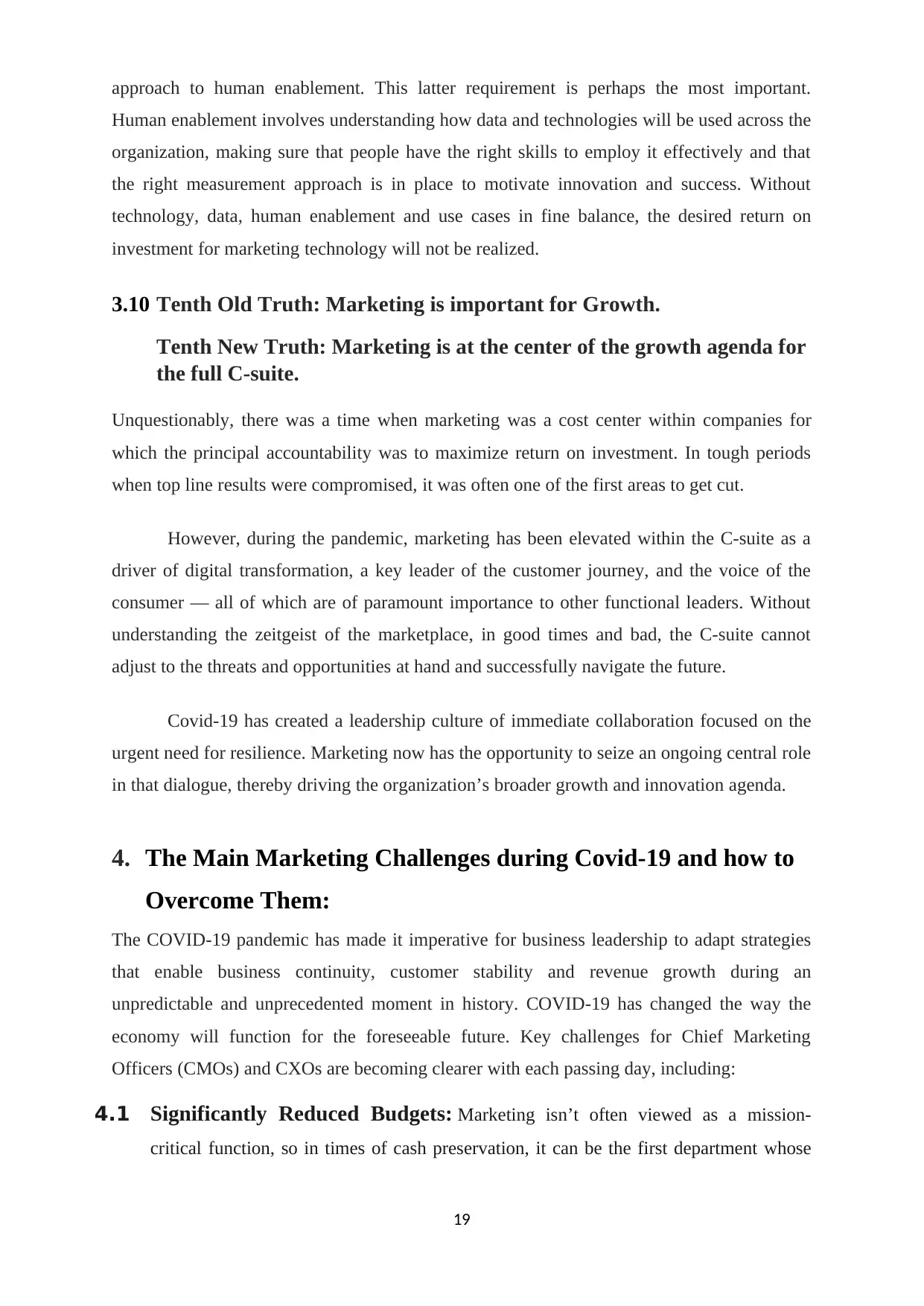
approach to human enablement. This latter requirement is perhaps the most important.
Human enablement involves understanding how data and technologies will be used across the
organization, making sure that people have the right skills to employ it effectively and that
the right measurement approach is in place to motivate innovation and success. Without
technology, data, human enablement and use cases in fine balance, the desired return on
investment for marketing technology will not be realized.
3.10 Tenth Old Truth: Marketing is important for Growth.
Tenth New Truth: Marketing is at the center of the growth agenda for
the full C-suite.
Unquestionably, there was a time when marketing was a cost center within companies for
which the principal accountability was to maximize return on investment. In tough periods
when top line results were compromised, it was often one of the first areas to get cut.
However, during the pandemic, marketing has been elevated within the C-suite as a
driver of digital transformation, a key leader of the customer journey, and the voice of the
consumer — all of which are of paramount importance to other functional leaders. Without
understanding the zeitgeist of the marketplace, in good times and bad, the C-suite cannot
adjust to the threats and opportunities at hand and successfully navigate the future.
Covid-19 has created a leadership culture of immediate collaboration focused on the
urgent need for resilience. Marketing now has the opportunity to seize an ongoing central role
in that dialogue, thereby driving the organization’s broader growth and innovation agenda.
4. The Main Marketing Challenges during Covid-19 and how to
Overcome Them:
The COVID-19 pandemic has made it imperative for business leadership to adapt strategies
that enable business continuity, customer stability and revenue growth during an
unpredictable and unprecedented moment in history. COVID-19 has changed the way the
economy will function for the foreseeable future. Key challenges for Chief Marketing
Officers (CMOs) and CXOs are becoming clearer with each passing day, including:
4.1 Significantly Reduced Budgets: Marketing isn’t often viewed as a mission-
critical function, so in times of cash preservation, it can be the first department whose
19
Human enablement involves understanding how data and technologies will be used across the
organization, making sure that people have the right skills to employ it effectively and that
the right measurement approach is in place to motivate innovation and success. Without
technology, data, human enablement and use cases in fine balance, the desired return on
investment for marketing technology will not be realized.
3.10 Tenth Old Truth: Marketing is important for Growth.
Tenth New Truth: Marketing is at the center of the growth agenda for
the full C-suite.
Unquestionably, there was a time when marketing was a cost center within companies for
which the principal accountability was to maximize return on investment. In tough periods
when top line results were compromised, it was often one of the first areas to get cut.
However, during the pandemic, marketing has been elevated within the C-suite as a
driver of digital transformation, a key leader of the customer journey, and the voice of the
consumer — all of which are of paramount importance to other functional leaders. Without
understanding the zeitgeist of the marketplace, in good times and bad, the C-suite cannot
adjust to the threats and opportunities at hand and successfully navigate the future.
Covid-19 has created a leadership culture of immediate collaboration focused on the
urgent need for resilience. Marketing now has the opportunity to seize an ongoing central role
in that dialogue, thereby driving the organization’s broader growth and innovation agenda.
4. The Main Marketing Challenges during Covid-19 and how to
Overcome Them:
The COVID-19 pandemic has made it imperative for business leadership to adapt strategies
that enable business continuity, customer stability and revenue growth during an
unpredictable and unprecedented moment in history. COVID-19 has changed the way the
economy will function for the foreseeable future. Key challenges for Chief Marketing
Officers (CMOs) and CXOs are becoming clearer with each passing day, including:
4.1 Significantly Reduced Budgets: Marketing isn’t often viewed as a mission-
critical function, so in times of cash preservation, it can be the first department whose
19
Paraphrase This Document
Need a fresh take? Get an instant paraphrase of this document with our AI Paraphraser
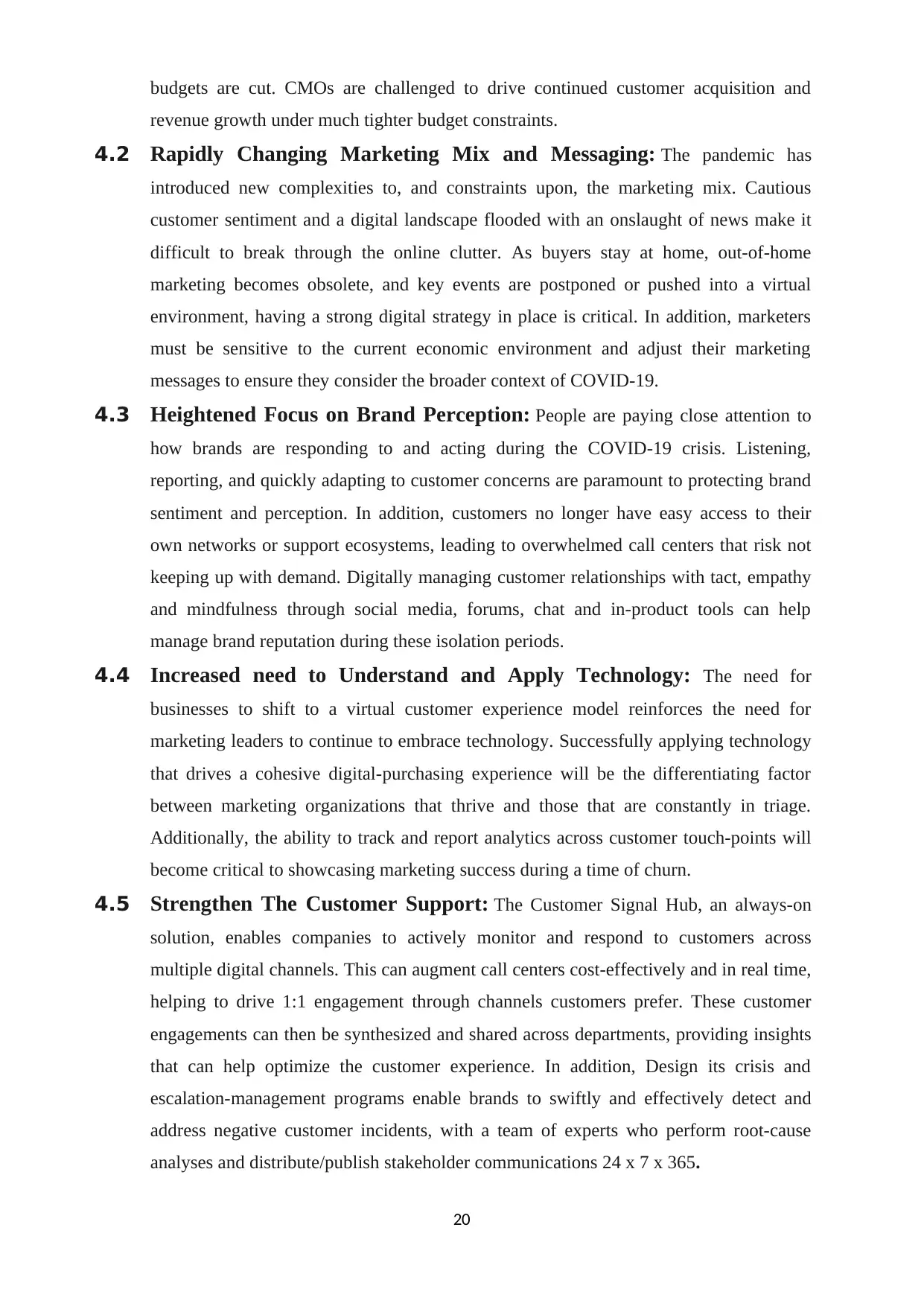
budgets are cut. CMOs are challenged to drive continued customer acquisition and
revenue growth under much tighter budget constraints.
4.2 Rapidly Changing Marketing Mix and Messaging: The pandemic has
introduced new complexities to, and constraints upon, the marketing mix. Cautious
customer sentiment and a digital landscape flooded with an onslaught of news make it
difficult to break through the online clutter. As buyers stay at home, out-of-home
marketing becomes obsolete, and key events are postponed or pushed into a virtual
environment, having a strong digital strategy in place is critical. In addition, marketers
must be sensitive to the current economic environment and adjust their marketing
messages to ensure they consider the broader context of COVID-19.
4.3 Heightened Focus on Brand Perception: People are paying close attention to
how brands are responding to and acting during the COVID-19 crisis. Listening,
reporting, and quickly adapting to customer concerns are paramount to protecting brand
sentiment and perception. In addition, customers no longer have easy access to their
own networks or support ecosystems, leading to overwhelmed call centers that risk not
keeping up with demand. Digitally managing customer relationships with tact, empathy
and mindfulness through social media, forums, chat and in-product tools can help
manage brand reputation during these isolation periods.
4.4 Increased need to Understand and Apply Technology: The need for
businesses to shift to a virtual customer experience model reinforces the need for
marketing leaders to continue to embrace technology. Successfully applying technology
that drives a cohesive digital-purchasing experience will be the differentiating factor
between marketing organizations that thrive and those that are constantly in triage.
Additionally, the ability to track and report analytics across customer touch-points will
become critical to showcasing marketing success during a time of churn.
4.5 Strengthen The Customer Support: The Customer Signal Hub, an always-on
solution, enables companies to actively monitor and respond to customers across
multiple digital channels. This can augment call centers cost-effectively and in real time,
helping to drive 1:1 engagement through channels customers prefer. These customer
engagements can then be synthesized and shared across departments, providing insights
that can help optimize the customer experience. In addition, Design its crisis and
escalation-management programs enable brands to swiftly and effectively detect and
address negative customer incidents, with a team of experts who perform root-cause
analyses and distribute/publish stakeholder communications 24 x 7 x 365.
20
revenue growth under much tighter budget constraints.
4.2 Rapidly Changing Marketing Mix and Messaging: The pandemic has
introduced new complexities to, and constraints upon, the marketing mix. Cautious
customer sentiment and a digital landscape flooded with an onslaught of news make it
difficult to break through the online clutter. As buyers stay at home, out-of-home
marketing becomes obsolete, and key events are postponed or pushed into a virtual
environment, having a strong digital strategy in place is critical. In addition, marketers
must be sensitive to the current economic environment and adjust their marketing
messages to ensure they consider the broader context of COVID-19.
4.3 Heightened Focus on Brand Perception: People are paying close attention to
how brands are responding to and acting during the COVID-19 crisis. Listening,
reporting, and quickly adapting to customer concerns are paramount to protecting brand
sentiment and perception. In addition, customers no longer have easy access to their
own networks or support ecosystems, leading to overwhelmed call centers that risk not
keeping up with demand. Digitally managing customer relationships with tact, empathy
and mindfulness through social media, forums, chat and in-product tools can help
manage brand reputation during these isolation periods.
4.4 Increased need to Understand and Apply Technology: The need for
businesses to shift to a virtual customer experience model reinforces the need for
marketing leaders to continue to embrace technology. Successfully applying technology
that drives a cohesive digital-purchasing experience will be the differentiating factor
between marketing organizations that thrive and those that are constantly in triage.
Additionally, the ability to track and report analytics across customer touch-points will
become critical to showcasing marketing success during a time of churn.
4.5 Strengthen The Customer Support: The Customer Signal Hub, an always-on
solution, enables companies to actively monitor and respond to customers across
multiple digital channels. This can augment call centers cost-effectively and in real time,
helping to drive 1:1 engagement through channels customers prefer. These customer
engagements can then be synthesized and shared across departments, providing insights
that can help optimize the customer experience. In addition, Design its crisis and
escalation-management programs enable brands to swiftly and effectively detect and
address negative customer incidents, with a team of experts who perform root-cause
analyses and distribute/publish stakeholder communications 24 x 7 x 365.
20
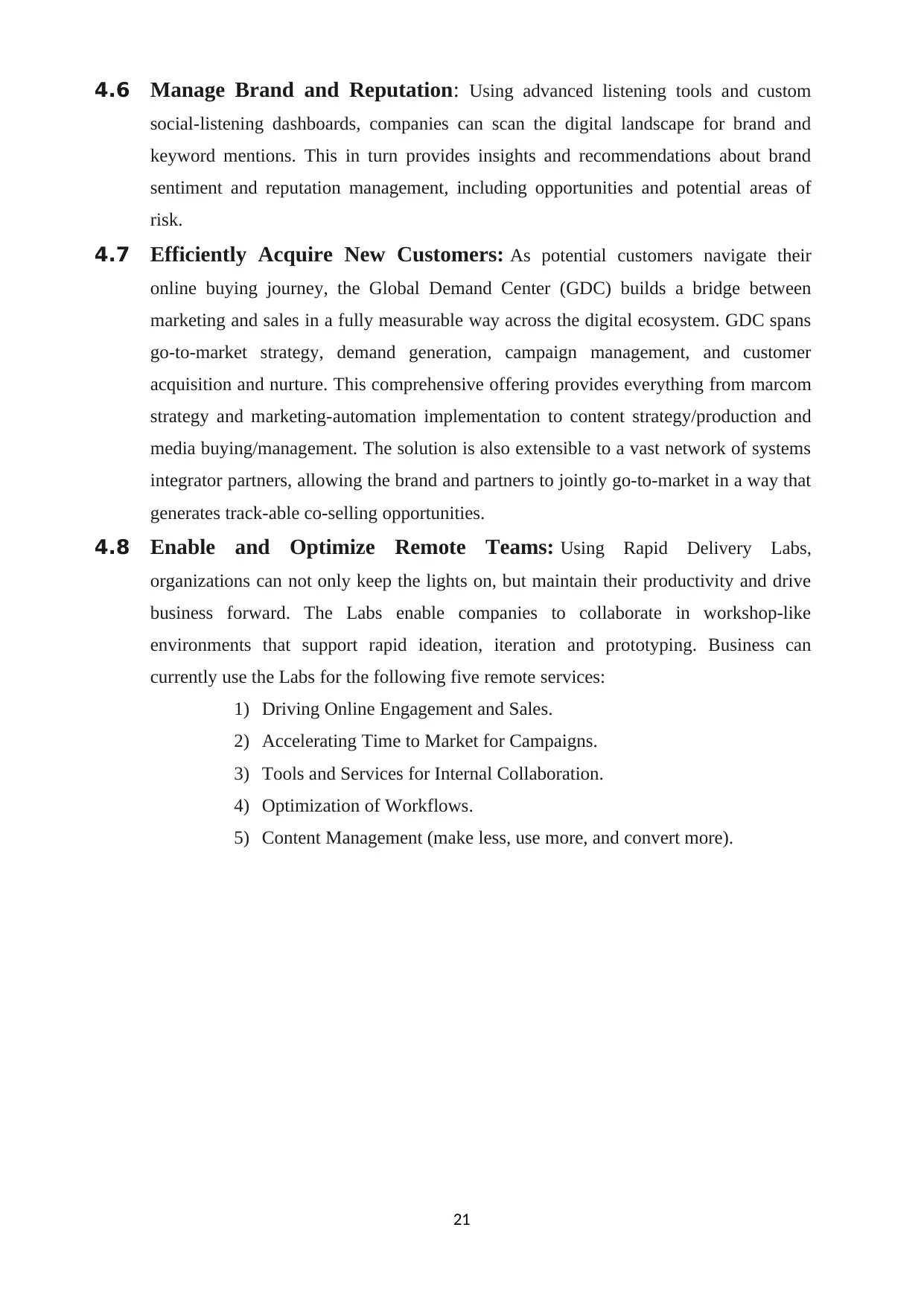
4.6 Manage Brand and Reputation: Using advanced listening tools and custom
social-listening dashboards, companies can scan the digital landscape for brand and
keyword mentions. This in turn provides insights and recommendations about brand
sentiment and reputation management, including opportunities and potential areas of
risk.
4.7 Efficiently Acquire New Customers: As potential customers navigate their
online buying journey, the Global Demand Center (GDC) builds a bridge between
marketing and sales in a fully measurable way across the digital ecosystem. GDC spans
go-to-market strategy, demand generation, campaign management, and customer
acquisition and nurture. This comprehensive offering provides everything from marcom
strategy and marketing-automation implementation to content strategy/production and
media buying/management. The solution is also extensible to a vast network of systems
integrator partners, allowing the brand and partners to jointly go-to-market in a way that
generates track-able co-selling opportunities.
4.8 Enable and Optimize Remote Teams: Using Rapid Delivery Labs,
organizations can not only keep the lights on, but maintain their productivity and drive
business forward. The Labs enable companies to collaborate in workshop-like
environments that support rapid ideation, iteration and prototyping. Business can
currently use the Labs for the following five remote services:
1) Driving Online Engagement and Sales.
2) Accelerating Time to Market for Campaigns.
3) Tools and Services for Internal Collaboration.
4) Optimization of Workflows.
5) Content Management (make less, use more, and convert more).
21
social-listening dashboards, companies can scan the digital landscape for brand and
keyword mentions. This in turn provides insights and recommendations about brand
sentiment and reputation management, including opportunities and potential areas of
risk.
4.7 Efficiently Acquire New Customers: As potential customers navigate their
online buying journey, the Global Demand Center (GDC) builds a bridge between
marketing and sales in a fully measurable way across the digital ecosystem. GDC spans
go-to-market strategy, demand generation, campaign management, and customer
acquisition and nurture. This comprehensive offering provides everything from marcom
strategy and marketing-automation implementation to content strategy/production and
media buying/management. The solution is also extensible to a vast network of systems
integrator partners, allowing the brand and partners to jointly go-to-market in a way that
generates track-able co-selling opportunities.
4.8 Enable and Optimize Remote Teams: Using Rapid Delivery Labs,
organizations can not only keep the lights on, but maintain their productivity and drive
business forward. The Labs enable companies to collaborate in workshop-like
environments that support rapid ideation, iteration and prototyping. Business can
currently use the Labs for the following five remote services:
1) Driving Online Engagement and Sales.
2) Accelerating Time to Market for Campaigns.
3) Tools and Services for Internal Collaboration.
4) Optimization of Workflows.
5) Content Management (make less, use more, and convert more).
21
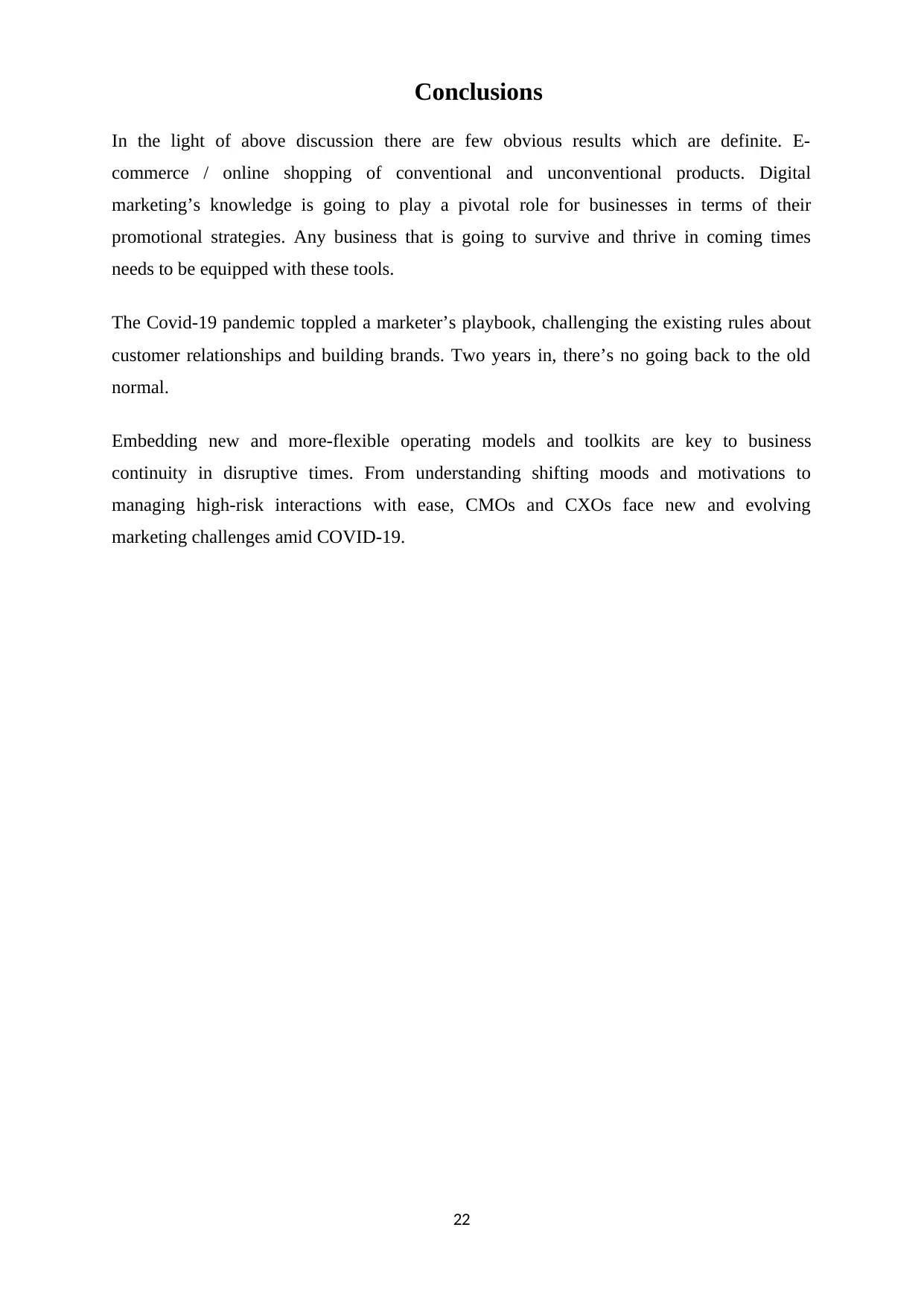
Conclusions
In the light of above discussion there are few obvious results which are definite. E-
commerce / online shopping of conventional and unconventional products. Digital
marketing’s knowledge is going to play a pivotal role for businesses in terms of their
promotional strategies. Any business that is going to survive and thrive in coming times
needs to be equipped with these tools.
The Covid-19 pandemic toppled a marketer’s playbook, challenging the existing rules about
customer relationships and building brands. Two years in, there’s no going back to the old
normal.
Embedding new and more-flexible operating models and toolkits are key to business
continuity in disruptive times. From understanding shifting moods and motivations to
managing high-risk interactions with ease, CMOs and CXOs face new and evolving
marketing challenges amid COVID-19.
22
In the light of above discussion there are few obvious results which are definite. E-
commerce / online shopping of conventional and unconventional products. Digital
marketing’s knowledge is going to play a pivotal role for businesses in terms of their
promotional strategies. Any business that is going to survive and thrive in coming times
needs to be equipped with these tools.
The Covid-19 pandemic toppled a marketer’s playbook, challenging the existing rules about
customer relationships and building brands. Two years in, there’s no going back to the old
normal.
Embedding new and more-flexible operating models and toolkits are key to business
continuity in disruptive times. From understanding shifting moods and motivations to
managing high-risk interactions with ease, CMOs and CXOs face new and evolving
marketing challenges amid COVID-19.
22
Secure Best Marks with AI Grader
Need help grading? Try our AI Grader for instant feedback on your assignments.
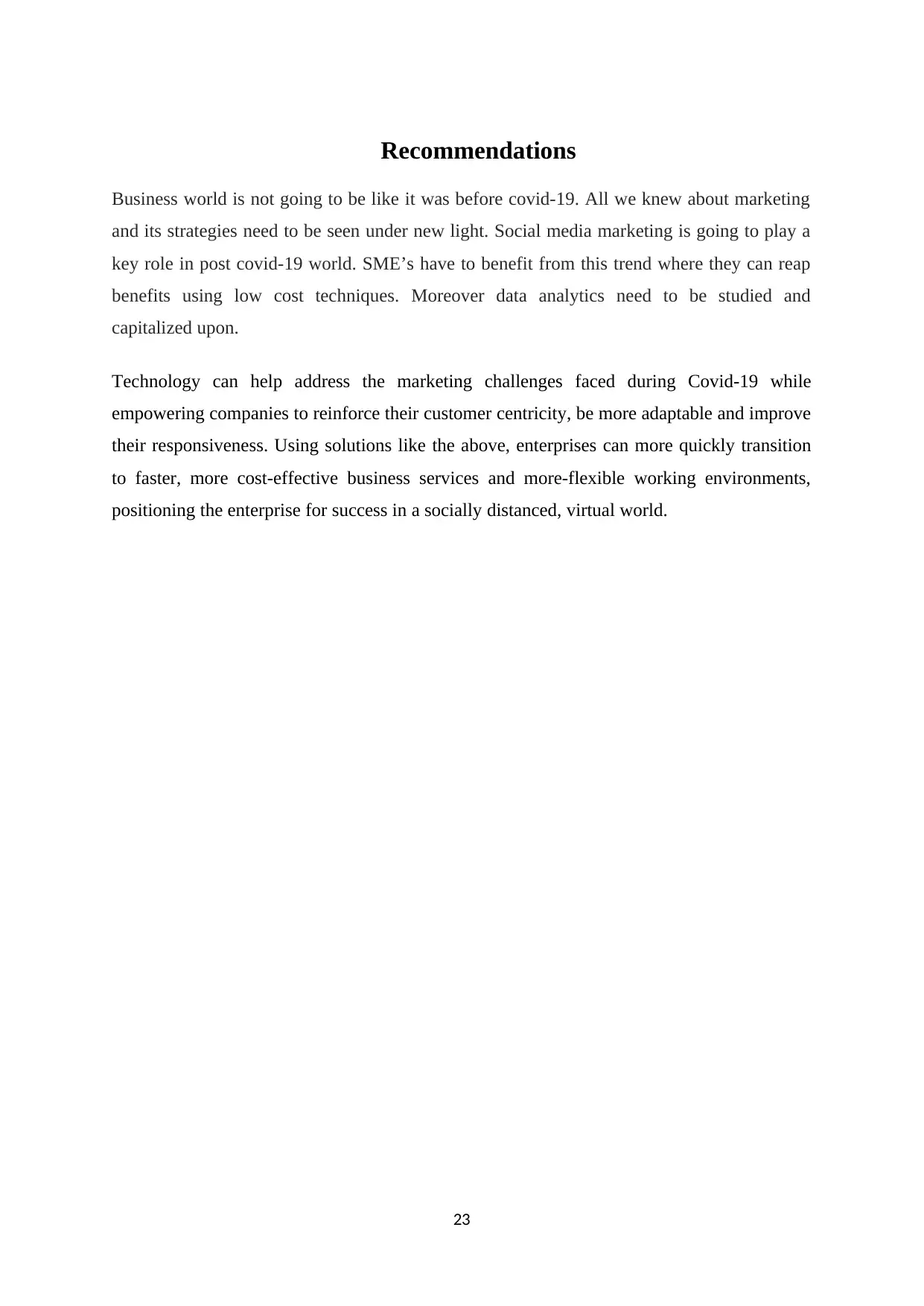
Recommendations
Business world is not going to be like it was before covid-19. All we knew about marketing
and its strategies need to be seen under new light. Social media marketing is going to play a
key role in post covid-19 world. SME’s have to benefit from this trend where they can reap
benefits using low cost techniques. Moreover data analytics need to be studied and
capitalized upon.
Technology can help address the marketing challenges faced during Covid-19 while
empowering companies to reinforce their customer centricity, be more adaptable and improve
their responsiveness. Using solutions like the above, enterprises can more quickly transition
to faster, more cost-effective business services and more-flexible working environments,
positioning the enterprise for success in a socially distanced, virtual world.
23
Business world is not going to be like it was before covid-19. All we knew about marketing
and its strategies need to be seen under new light. Social media marketing is going to play a
key role in post covid-19 world. SME’s have to benefit from this trend where they can reap
benefits using low cost techniques. Moreover data analytics need to be studied and
capitalized upon.
Technology can help address the marketing challenges faced during Covid-19 while
empowering companies to reinforce their customer centricity, be more adaptable and improve
their responsiveness. Using solutions like the above, enterprises can more quickly transition
to faster, more cost-effective business services and more-flexible working environments,
positioning the enterprise for success in a socially distanced, virtual world.
23
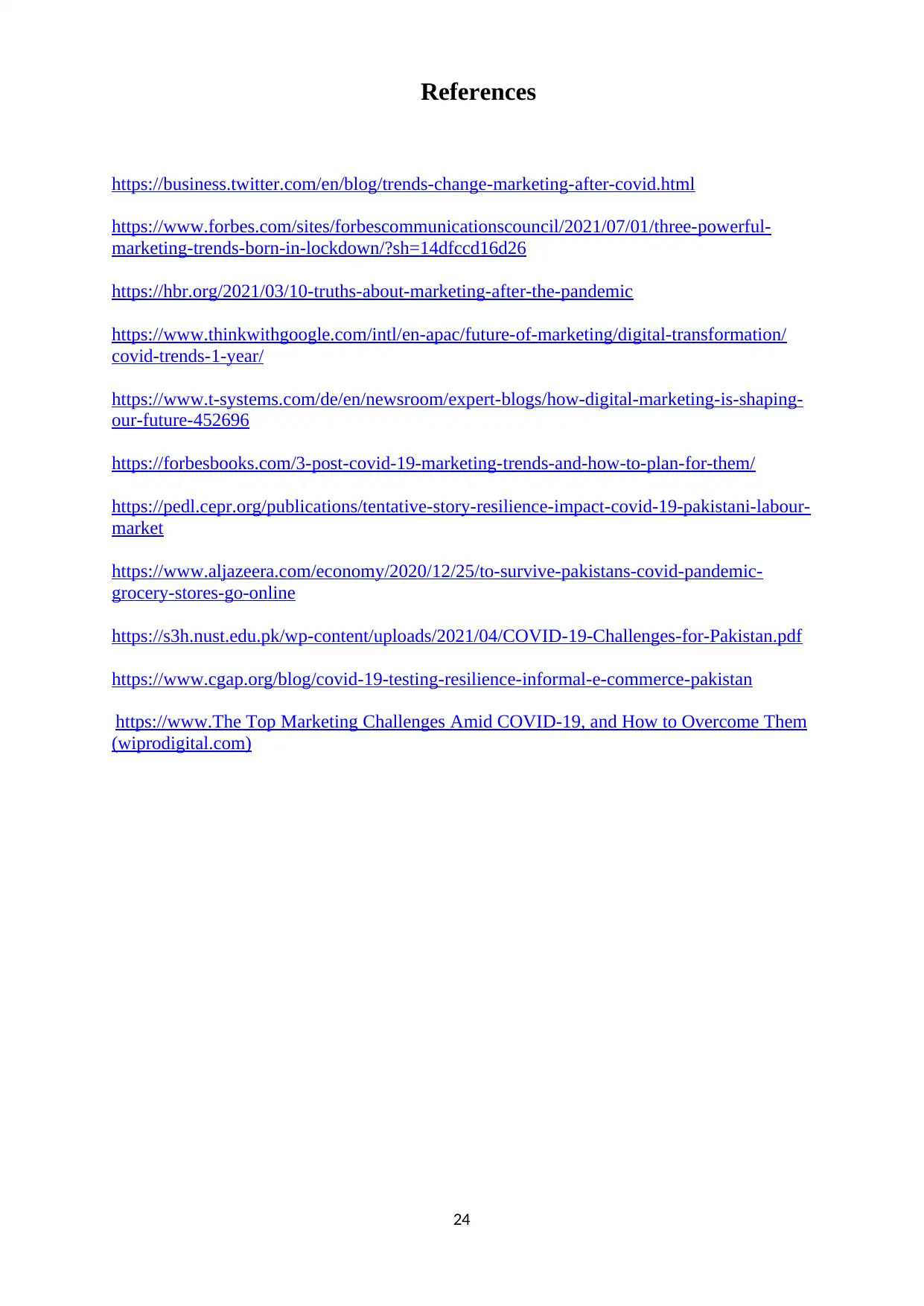
References
https://business.twitter.com/en/blog/trends-change-marketing-after-covid.html
https://www.forbes.com/sites/forbescommunicationscouncil/2021/07/01/three-powerful-
marketing-trends-born-in-lockdown/?sh=14dfccd16d26
https://hbr.org/2021/03/10-truths-about-marketing-after-the-pandemic
https://www.thinkwithgoogle.com/intl/en-apac/future-of-marketing/digital-transformation/
covid-trends-1-year/
https://www.t-systems.com/de/en/newsroom/expert-blogs/how-digital-marketing-is-shaping-
our-future-452696
https://forbesbooks.com/3-post-covid-19-marketing-trends-and-how-to-plan-for-them/
https://pedl.cepr.org/publications/tentative-story-resilience-impact-covid-19-pakistani-labour-
market
https://www.aljazeera.com/economy/2020/12/25/to-survive-pakistans-covid-pandemic-
grocery-stores-go-online
https://s3h.nust.edu.pk/wp-content/uploads/2021/04/COVID-19-Challenges-for-Pakistan.pdf
https://www.cgap.org/blog/covid-19-testing-resilience-informal-e-commerce-pakistan
https://www.The Top Marketing Challenges Amid COVID-19, and How to Overcome Them
(wiprodigital.com)
24
https://business.twitter.com/en/blog/trends-change-marketing-after-covid.html
https://www.forbes.com/sites/forbescommunicationscouncil/2021/07/01/three-powerful-
marketing-trends-born-in-lockdown/?sh=14dfccd16d26
https://hbr.org/2021/03/10-truths-about-marketing-after-the-pandemic
https://www.thinkwithgoogle.com/intl/en-apac/future-of-marketing/digital-transformation/
covid-trends-1-year/
https://www.t-systems.com/de/en/newsroom/expert-blogs/how-digital-marketing-is-shaping-
our-future-452696
https://forbesbooks.com/3-post-covid-19-marketing-trends-and-how-to-plan-for-them/
https://pedl.cepr.org/publications/tentative-story-resilience-impact-covid-19-pakistani-labour-
market
https://www.aljazeera.com/economy/2020/12/25/to-survive-pakistans-covid-pandemic-
grocery-stores-go-online
https://s3h.nust.edu.pk/wp-content/uploads/2021/04/COVID-19-Challenges-for-Pakistan.pdf
https://www.cgap.org/blog/covid-19-testing-resilience-informal-e-commerce-pakistan
https://www.The Top Marketing Challenges Amid COVID-19, and How to Overcome Them
(wiprodigital.com)
24
1 out of 24
Your All-in-One AI-Powered Toolkit for Academic Success.
+13062052269
info@desklib.com
Available 24*7 on WhatsApp / Email
![[object Object]](/_next/static/media/star-bottom.7253800d.svg)
Unlock your academic potential
© 2024 | Zucol Services PVT LTD | All rights reserved.